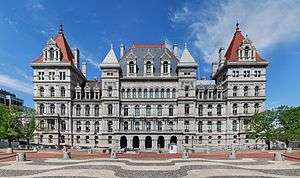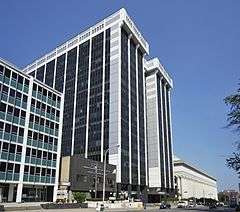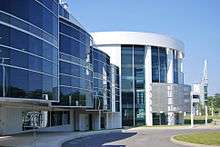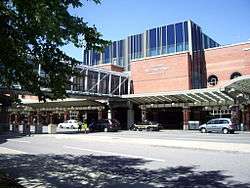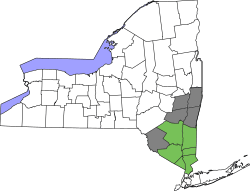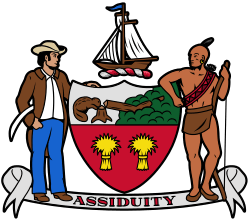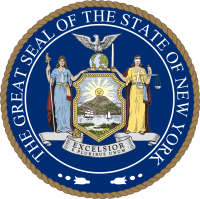Albany, New York
Albany (/ˈɔːlbəni/ (![]()
Albany | |
|---|---|
State capital city | |
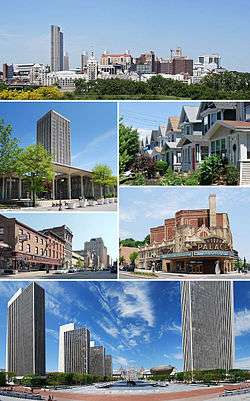 Clockwise from top: Downtown from Rensselaer; middle-class housing in the Helderberg neighborhood; Palace Theatre; Empire State Plaza from the Cultural Education Center; North Pearl Street at Columbia Street; and the State Quad at SUNY Albany. | |
 Flag  Seal | |
| Etymology: Named for the Scottish Duke of Albany, whose title comes from the Gaelic name for Scotland: Alba | |
| Nicknames: | |
| Motto(s): Assiduity[lower-alpha 3] | |
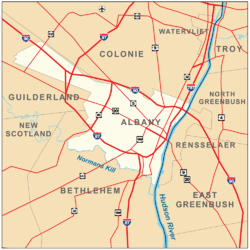 Boundaries of and major thoroughfares through Albany | |
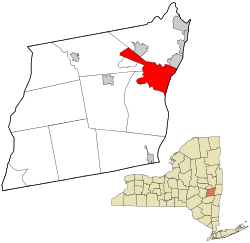 Location in Albany County and the state of New York | |
 Albany Location within New York (state)  Albany Location within the United States  Albany Location within North America | |
| Coordinates: 42°39′09″N 073°45′26″W | |
| Country | |
| State | |
| Region | Capital District |
| County | Albany |
| Settled | 1614 |
| Incorporation | 1686 |
| Government | |
| • Type | Mayor-council |
| • Mayor | Kathy Sheehan (D) |
| Area | |
| • State capital city | 21.94 sq mi (56.81 km2) |
| • Land | 21.40 sq mi (55.43 km2) |
| • Water | 0.53 sq mi (1.38 km2) |
| • Metro | 6,570 sq mi (17,000 km2) |
| Elevation | 141 ft (43 m) |
| Highest elevation | 378 ft (115 m) |
| Lowest elevation | 2 ft (0.6 m) |
| Population (2010) | |
| • State capital city | 97,856 |
| • Estimate (2019)[6] | 96,460 |
| • Density | 4,506.84/sq mi (1,740.11/km2) |
| • Metro | 1,170,483 |
| • Metro density | 180/sq mi (69/km2) |
| Demonym(s) | Albanian[7] |
| Time zone | UTC−5 (EST) |
| • Summer (DST) | UTC−4 (EDT) |
| ZIP Codes | 12201–12212, 12214, 12220, 12222–12232 |
| Area codes | 518, 838 |
| Geocode | 977310, 978659 |
| ISO 3166 code | 36-01000 |
| FIPS code | 36-01000 |
| GNIS feature ID | 978659 |
| Website | www |
Albany is known for its rich history, commerce, culture, architecture, and institutions of higher education. Albany constitutes the economic and cultural core of the Capital District of New York State, which comprises the Albany–Schenectady–Troy, NY Metropolitan Statistical Area, including the nearby cities and suburbs of Troy, Schenectady, and Saratoga Springs. With a 2013 Census-estimated population of 1.1 million[9] the Capital District is the third-most populous metropolitan region in the state. As of the 2010 census, the population of Albany was 97,856.
The area that later became Albany was settled by Dutch colonists who, in 1614, built Fort Nassau for fur trading and, in 1624, built Fort Orange. In 1664, the English took over the Dutch settlements, renaming the city as Albany, in honor of the then Duke of Albany, the future James II of England and James VII of Scotland. The city was officially chartered in 1686 under English rule. It became the capital of New York in 1797 following formation of the United States. Albany is one of the oldest surviving settlements of the original British thirteen colonies, and is the longest continuously chartered city in the United States.[10]
During the late 18th century and throughout most of the 19th, Albany was a center of trade and transportation. The city lies toward the north end of the navigable Hudson River, was the original eastern terminus of the Erie Canal connecting to the Great Lakes, and was home to some of the earliest railroad systems in the world. In the 1920s, a powerful political machine controlled by the Democratic Party arose in Albany. In the latter part of the 20th century, Albany experienced a decline in its population due to urban sprawl and suburbanization; however, the New York State Legislature approved a $234 million building and renovation plan for the City in the 1990s that spurred renovation and building projects around the downtown area.[11] In the early 21st century, Albany has experienced growth in the high-technology industry, with great strides in the nanotechnology sector.[12][13]
History
Colonial times to 1800
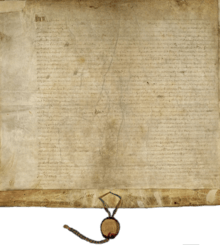

Albany is one of the oldest surviving European settlements from the original thirteen colonies[14] and the longest continuously chartered city in the United States.[lower-alpha 6] The Hudson River area was originally inhabited by Algonquian-speaking Mohican (Mahican), who called it Pempotowwuthut-Muhhcanneuw, meaning "the fireplace of the Mohican nation."[17] Based to the west along the Mohawk River, the Iroquoian-speaking Mohawk referred to it as Sche-negh-ta-da, or "through the pine woods," referring to the path they took there.[18][lower-alpha 7] The Mohawk were one of the Five Nations of the Iroquois Confederacy, or Haudenosaunee, and became strong trading partners with the Dutch and English. It is likely the Albany area was visited by European fur traders, perhaps as early as 1540, but the extent and duration of those visits has not been determined.[20]
Permanent European claims began when Englishman Henry Hudson, exploring for the Dutch East India Company on the Half Moon (Dutch: Halve Maen), reached the area in 1609, claiming it for the United Netherlands.[21] In 1614, Hendrick Christiaensen built Fort Nassau, a fur-trading post and the first documented European structure in present-day Albany. Commencement of the fur trade provoked hostility from the French colony in Canada and among the natives, all of whom vied to control the trade. In 1618, a flood ruined the fort on Castle Island, but it was rebuilt in 1624 as Fort Orange.[22] Both forts were named in honor of the leading family of the Dutch Revolt, members of the House of Orange-Nassau.[23] Fort Orange and the surrounding area were incorporated as the village of Beverwijck (English: Beaverwick or Beaver District) in 1652.[24][25] In these early decades of trade, the Dutch, Mohican and Mohawk developed relations that reflected differences among their three cultures.[26]
When New Netherland was captured by the English in 1664, the name was changed from Beverwijck to Albany in honor of the Duke of Albany (later James II of England and James VII of Scotland).[27][lower-alpha 8] Duke of Albany was a Scottish title given since 1398, generally to a younger son of the King of Scots.[28] The name is ultimately derived from Alba, the Gaelic name for Scotland.[29] The Dutch briefly regained Albany in August 1673 and renamed the city Willemstadt; the English took permanent possession with the Treaty of Westminster (1674).[30] On November 1, 1683, the Province of New York was split into counties, with Albany County being the largest. At that time the county included all of present New York State north of Dutchess and Ulster Counties in addition to present-day Bennington County, Vermont, theoretically stretching west to the Pacific Ocean;[31][32] Albany became the county seat.[33] Albany was formally chartered as a municipality by provincial Governor Thomas Dongan on July 22, 1686. The Dongan Charter was virtually identical in content to the charter awarded to the city of New York three months earlier.[34] Dongan created Albany as a strip of land 1 mile (1.6 km) wide and 16 miles (26 km) long.[35] Over the years Albany would lose much of the land to the west and annex land to the north and south. At this point, Albany had a population of about 500 people.[36]
In 1754, representatives of seven British North American colonies met in the Stadt Huys, Albany's city hall, for the Albany Congress; Benjamin Franklin of Pennsylvania presented the Albany Plan of Union there, which was the first formal proposal to unite the colonies.[37] Although it was never adopted by Parliament, it was an important precursor to the United States Constitution.[38][lower-alpha 9] The same year, the French and Indian War, the fourth in a series of wars dating back to 1689, began; it ended in 1763 with French defeat, resolving a situation that had been a constant threat to Albany and held back its growth.[39] In 1775, with the colonies in the midst of the Revolutionary War, the Stadt Huys became home to the Albany Committee of Correspondence (the political arm of the local revolutionary movement), which took over operation of Albany's government and eventually expanded its power to control all of Albany County. Tories and prisoners of war were often jailed in the Stadt Huys alongside common criminals.[40] In 1776, Albany native Philip Livingston signed the Declaration of Independence at Independence Hall in Philadelphia.[41]
During and after the Revolutionary War, Albany County saw a great increase in real estate transactions. After Horatio Gates defeated John Burgoyne at Saratoga in 1777, the upper Hudson Valley was generally at peace as the war raged on elsewhere. Prosperity was soon seen all over Upstate New York. Migrants from Vermont and Connecticut began flowing in, noting the advantages of living on the Hudson and trading at Albany, while being only a few days' sail from New York City.[42] Albany reported a population of 3,498 in the first national census in 1790, an increase of almost 700% since its chartering.[36]
On November 17, 1793, a large fire broke out, destroying 26 homes on Broadway, Maiden Lane, James Street, and State Street. The fire originated at a stable belonging to Leonard Gansevoort and was suspected to be arson set by disgruntled slaves. Three slaves were arrested and charged with arson: a male slave named Pompey, owned by Matthew Visscher; a 14-year old slave girl named Dinah, owned by Volkert P. Douw; and a 12-year old slave girl named Bet, owned by Philip S. Van Rensselaer. On January 6, 1794, the three were tried and sentenced to death. For reasons unknown, Governor George Clinton issued a temporary stay of execution, but the slave girls were executed by hanging on March 14, and Pompey on April 11, 1794.[43]
In 1797, the state capital of New York was moved permanently to Albany. From statehood to this date, the Legislature had frequently moved the state capital between Albany, Kingston, Hurley, Poughkeepsie, and the city of New York.[44] Albany is the tenth-oldest state capital in the United States, but is the second-oldest city that is a state capital, after Santa Fe, New Mexico.[45]
1800 to 1942
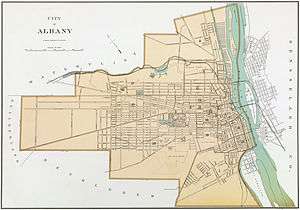
Albany has been a center of transportation for much of its history. In the late 18th and early 19th centuries, Albany saw development of the turnpike and by 1815, Albany was the turnpike center of the state. Simeon De Witt developed a grid block system in 1794, and renamed streets that had honored British royalty, using names of birds and mammals instead.[lower-alpha 10] This grid was intersected by the major arterials coming out of Albany, which cut through the city at unexpected angles.[48][49] The construction of the turnpike across the state, in conjunction with canal and railroad systems, made Albany the hub of transportation for pioneers going to Buffalo and the Michigan Territory in the early- and mid-19th century.
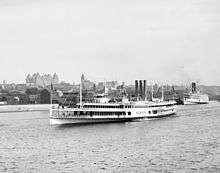
In 1807, Robert Fulton initiated a steamboat line from New York to Albany, the first successful enterprise of its kind anywhere in the world.[50] By 1810, with 10,763 people, Albany was the 10th-largest urban place in the nation.[51] The town and village north of Albany known as "the Colonie"[lower-alpha 11] was annexed in 1815.[52] In 1825 the Erie Canal was completed, forming a continuous water route from the Great Lakes to New York City. Unlike the current Barge Canal, which ends at nearby Waterford, the original Erie Canal ended at Albany; Lock 1 was north of Colonie Street.[54] The Canal emptied into a 32-acre (13 ha) man-made lagoon called the Albany Basin, which was Albany's main port from 1825 until the Port of Albany-Rensselaer opened in 1932.[55][56] In 1829, while working as a professor at the Albany Academy, Joseph Henry, widely regarded as "the foremost American scientist of the 19th century",[57] built the first electric motor. Three years later, he discovered electromagnetic self-induction (the SI unit for which is now the henry). He went on to be the first Secretary of the Smithsonian Institution.[58] In the 1830 and 1840 censuses, Albany was ranked as the 9th-largest urban place in the nation;[59][60] it dropped back to 10th in 1850.[61] This was the last time the city was one of the top ten largest urban places in the nation.[62]
Albany also has significant history with rail transport,[63] as the location of two major regional railroad headquarters. The Delaware and Hudson Railway was headquartered in Albany at what is now the SUNY System Administration Building.[64] In 1853, Erastus Corning, a noted industrialist and Albany's mayor from 1834 to 1837, consolidated ten railroads stretching from Albany to Buffalo into the New York Central Railroad (NYCRR), headquartered in Albany until Cornelius Vanderbilt moved it to New York City in 1867.[65][66] One of the ten companies that formed the NYCRR was the Mohawk and Hudson Railroad, which was the first railroad in the state and the first successful steam railroad running regularly scheduled service in the country.[67][68]
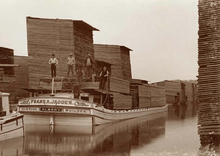
While the key to Albany's economic prosperity in the 19th century was transportation, industry and business also played a role. Largely thanks to the city's Dutch and German roots, beer was one of its biggest commodities. Beverwyck Brewery, originally known as Quinn and Nolan (Nolan being mayor of Albany 1878–1883),[70] was the last remaining brewer from that time when it closed in 1972. The city's location at the east end of the Erie Canal gave it unparalleled access to both raw products and a captive customer base in the west.[71] Albany was known for its publishing houses, and to some extent, still is. Albany was second only to Boston in the number of books produced for most of the 19th century.[72] Iron foundries in both the north and south ends of the city attracted thousands of immigrants to the city for industrial jobs. To this day, one can see many intricate wrought-iron details that were constructed in those years on what are now historic buildings. The iron industry waned by the 1890s due to increased costs associated with a newly unionized workforce and the opening of mines in the Mesabi Range in Minnesota.[73]
Albany's other major exports during the 18th and 19th centuries were furs, wheat, meat, and lumber.[74] By 1865, there were almost 4,000 saw mills in the Albany area[74] and the Albany Lumber District was the largest lumber market in the nation.[69] The city was also home to a number of banks. The Bank of Albany (1792–1861) was the second chartered bank in New York.[75] The city was the original home of the Albank (founded in 1820 as the Albany Savings Bank),[76] KeyBank (founded in 1825 as the Commercial Bank of Albany),[77] and Norstar Bank (founded as the State Bank of Albany in 1803).[78] American Express was founded in Albany in 1850 as an express mail business.[79] In 1871, the northwestern portion of Albany—west from Magazine Street—was annexed to the neighboring town of Guilderland[80] after the town of Watervliet refused annexation of said territory.[81][82] In return for this loss, portions of Bethlehem and Watervliet were added to Albany. Part of the land annexed to Guilderland was ceded back to Albany in 1910, setting up the current western border.[52]
Albany opened one of the first commercial airports in the world, and the first municipal airport in the United States, in 1908. Originally on a polo field on Loudon Road, it moved to Westerlo Island in 1909 and remained there until 1928. The Albany Municipal Airport—jointly owned by the city and county—was moved to its current location in Colonie in 1928. By 1916 Albany's northern and southern borders reached their modern courses;[52] Westerlo Island, to the south, became the second-to-last annexation, which occurred in 1926.[83]
1942 to present day
Erastus Corning 2nd, arguably Albany's most notable mayor (and great-grandson of the former mayor of the same name), was elected in 1941.[84] Although he was one of the longest-serving mayors of any city in United States history (1942 until his death in 1983), one historian describes Corning's tenure as "long on years, short on accomplishments."[85] Grondahl cited Corning's preference for maintaining the status quo as a factor that held back potential progress during his tenure.[86] While Corning brought stability to the office of mayor, it is said even those who admire him greatly cannot come up with a sizable list of "major concrete Corning achievements."[87] Corning is given credit for saving—albeit somewhat unintentionally—much of Albany's historic architecture.[lower-alpha 12]
During the 1950s and 1960s, a time when federal aid for urban renewal was plentiful,[86] Albany did not have growth in its economy or infrastructure. It lost more than 20 percent of its population during the Corning years, as people moved to newer housing in the suburbs, followed by most of the downtown businesses moving there as well.[88] While cities across the country grappled with similar issues, the problems were magnified in Albany: interference from the Democratic political machine hindered progress considerably.[86] In 1960, the mayor sold the city's stake in the airport to the county, citing budget issues. It was known from then on as Albany County Airport until a massive upgrade and modernization project between 1996 and 1998, when it was rechristened Albany International Airport.[89]
Governor Nelson Rockefeller (1959–1973) (R) tried to stimulate the city with new monumental architecture and large, government-sponsored building projects; he drove construction of the Empire State Plaza, SUNY Albany's uptown campus, and much of the W. Averell Harriman State Office Building Campus.[90] Albany County Republican Chairman Joseph C. Frangella once quipped, "Governor Rockefeller was the best mayor Albany ever had."[91] Corning, although opposed to the project, was responsible for negotiating the payment plan for the Empire State Plaza. Rockefeller did not want to be limited by the Legislature's power of the purse, so Corning devised a plan to have the county pay for the construction and have the state sign a lease-ownership agreement. The state paid off the bonds until 2004. It was Rockefeller's only viable option, and he agreed. Due to the clout Corning gained from the situation, he gained inclusion of the State Museum, a convention center, and a restaurant, back in the plans—ideas which Rockefeller had originally vetoed. The county gained $35 million in fees and the city received $13 million for lost tax revenue. Having the state offices in the city enabled it to keep good jobs and retain middle-class residents.[92]
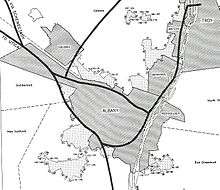
Another major project of the 1960s and 1970s was Interstate 787 and the South Mall Arterial.[lower-alpha 13] Construction began in the early 1960s. One of the project's main results, since regretted, was separating the city from the Hudson River, its source of development. Corning has been described as shortsighted with respect to use of the waterfront, as he could have used his influence to change the location of I-787, which now cuts the city off from "its whole raison d'être".[93] Much of the original plan never came to fruition, however: Rockefeller had wanted the South Mall Arterial to pass through the Empire State Plaza. The project would have required an underground trumpet interchange below Washington Park, connecting to the (eventually cancelled) Mid-Crosstown Arterial.[94] To this day, evidence of the original plan is still visible.[lower-alpha 14] In 1967 the hamlet of Karlsfeld was the last annexation by the city, taken from the Town of Bethlehem.[52]
When Corning died in 1983, Thomas Whalen assumed the mayorship and was reelected twice. He encouraged redevelopment of historic structures and helped attract federal dollars earmarked for that purpose. What Corning had saved from destruction, Whalen refurbished for continued and new uses.[95] The Mayor's Office of Special Events was created in an effort to increase the number of festivals and artistic events in the city, including a year-long Dongan Charter tricentennial celebration in 1986.[96] Whalen is credited for an "unparalleled cycle of commercial investment and development" in Albany due to his "aggressive business development programs".[97]
Prior to the recession of the 1990s, downtown Albany was home to four Fortune 500 companies.[98] After the death of Corning and the retirement of Congressman Sam Stratton, the political environment changed. Long-term office holders became rare in the 1980s. Local media began following the drama surrounding county politics (specifically that of the newly created county executive position); the loss of Corning (and eventually the machine) led to a lack of interest in city politics.[99] The election of Gerald Jennings was a surprise, and he served as Mayor from 1994 until his retirement at the end of 2013. His tenure essentially ended the political machine that had been in place since the 1920s.[100]
During the 1990s, the State Legislature approved the $234 million "Albany Plan", "a building and renovation project [that] was the most ambitious building project to affect the area since the Rockefeller era." Under the Albany Plan, renovation and new building projects were initiated around the downtown area. Many state workers were relocated from the Harriman State Office Campus to downtown, helping its retail businesses and vitality.[11]
Fortune 500 companies with offices in Albany include American Express, J.P. Morgan and Chase,[101] Merrill Lynch,[102][103] General Electric, Verizon, Goldman Sachs,[104] International Paper,[105] and Key Bank.[106]
Albany won the All-America City Award in both 1991 and 2009.[107]
Geography
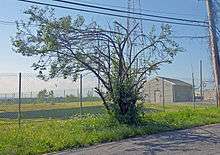
Albany is about 150 miles (240 km) north of New York City on the Hudson River.[24] It has a total area of 21.8 square miles (56 km2), of which 21.4 square miles (55 km2) is land and 0.4 square miles (1.0 km2) (1.8%) is water.[108] The city is bordered on the north by the town of Colonie (along with the village of Menands), on the west by the town of Guilderland, and on the south by the town of Bethlehem.[109] The Hudson River represents the city's eastern border. Patroon Creek, along the northern border, and the Normans Kill, along the southern border, are the two major streams in the city. The former Foxes Creek, Beaver Kill, and Rutten Kill still exist, but were diverted underground in the 19th century.[110][111][112] There are four lakes within city limits: Buckingham Lake; Rensselaer Lake at the mouth of the Patroon Creek; Tivoli Lake, which was formed as a reservoir and once connected to the Patroon Creek; and Washington Park Lake, which was formed by damming the Beaver Kill.[109][111]
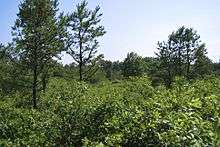
The highest natural point in Albany is a USGS benchmark near the Loudonville Reservoir off Birch Hill Road, at 378 feet (115 m) above sea level. The lowest point is sea level at the Hudson River (the average water elevation is 2 feet (0.61 m)),[109][114] which is still technically an estuary at Albany and is affected by the Atlantic tide.[115] The interior of Albany consists of rolling hills which were once part of the Albany Pine Bush, an area of pitch pine and scrub oak, and has arid, sandy soil that is a remnant of the ancient Lake Albany. Due to development, the Pine Bush has shrunk from an original 25,000 to 6,000 acres (10,100 to 2,400 ha) today. A preserve was set up by the State Legislature in 1988 and is on the city's western edge, spilling into Guilderland and Colonie;[116] it is the only sizable inland pine barrens sand dune ecosystem in the United States,[113] and is home to many endangered species, including the Karner Blue butterfly.[117]
Climate
Albany is in the humid continental climate zone (Köppen climate classification: Dfa),[118] and features cold, snowy winters, and warm, humid summers; the city experiences four distinct seasons. Albany is in plant hardiness zone 6a near downtown and along the shore of the Hudson and 5b at its western end.[119] Albany receives 39.4 inches (1,000 mm) of precipitation per year,[120] with 138 days of at least 0.01 in (0.25 mm) of precipitation each year. Snowfall is significant, totaling 60.3 inches (153 cm) per season,[120] but with less accumulation than the lake effect areas to the north and west, as it is farther from Lake Ontario. However, Albany is close enough to the Atlantic coast to receive heavy snow from Nor'easters and the city occasionally receives Alberta clippers.[121] Winters can be very cold with fluctuating conditions; temperatures drop to 0 °F (−18 °C) or below on nine nights per annum.[122] Summers in Albany can contain stretches of excessive heat and humidity, with temperatures of 90 °F (32 °C) or hotter on nine days per year.[122] Record temperature extremes range from −28 °F (−33 °C), on January 19, 1971, to 104 °F (40 °C) on July 4, 1911.[122]
| Climate data for Albany International Airport, New York (1981–2010 normals,[lower-alpha 15][lower-alpha 16] extremes 1874–present[lower-alpha 17]) | |||||||||||||
|---|---|---|---|---|---|---|---|---|---|---|---|---|---|
| Month | Jan | Feb | Mar | Apr | May | Jun | Jul | Aug | Sep | Oct | Nov | Dec | Year |
| Record high °F (°C) | 71 (22) |
74 (23) |
89 (32) |
93 (34) |
97 (36) |
100 (38) |
104 (40) |
102 (39) |
100 (38) |
91 (33) |
82 (28) |
72 (22) |
104 (40) |
| Mean maximum °F (°C) | 52.8 (11.6) |
53.5 (11.9) |
68.2 (20.1) |
81.6 (27.6) |
86.7 (30.4) |
91.1 (32.8) |
92.3 (33.5) |
91.2 (32.9) |
86.0 (30.0) |
76.8 (24.9) |
68.1 (20.1) |
54.8 (12.7) |
94.3 (34.6) |
| Average high °F (°C) | 30.6 (−0.8) |
34.6 (1.4) |
44.4 (6.9) |
58.3 (14.6) |
69.4 (20.8) |
77.9 (25.5) |
82.3 (27.9) |
80.4 (26.9) |
72.2 (22.3) |
59.8 (15.4) |
47.9 (8.8) |
35.8 (2.1) |
57.9 (14.4) |
| Average low °F (°C) | 14.5 (−9.7) |
17.3 (−8.2) |
25.7 (−3.5) |
37.3 (2.9) |
47.1 (8.4) |
56.5 (13.6) |
61.4 (16.3) |
59.9 (15.5) |
51.6 (10.9) |
39.6 (4.2) |
31.5 (−0.3) |
21.2 (−6.0) |
38.7 (3.7) |
| Mean minimum °F (°C) | −7.1 (−21.7) |
−2.8 (−19.3) |
6.5 (−14.2) |
23.2 (−4.9) |
32.7 (0.4) |
42.0 (5.6) |
49.5 (9.7) |
46.5 (8.1) |
36.1 (2.3) |
25.8 (−3.4) |
15.9 (−8.9) |
1.6 (−16.9) |
−9.6 (−23.1) |
| Record low °F (°C) | −28 (−33) |
−22 (−30) |
−21 (−29) |
9 (−13) |
26 (−3) |
35 (2) |
40 (4) |
34 (1) |
24 (−4) |
16 (−9) |
−11 (−24) |
−22 (−30) |
−28 (−33) |
| Average precipitation inches (mm) | 2.59 (66) |
2.20 (56) |
3.21 (82) |
3.17 (81) |
3.61 (92) |
3.79 (96) |
4.12 (105) |
3.46 (88) |
3.30 (84) |
3.68 (93) |
3.29 (84) |
2.93 (74) |
39.35 (999) |
| Average snowfall inches (cm) | 17.9 (45) |
12.2 (31) |
11.0 (28) |
2.3 (5.8) |
0.1 (0.25) |
0 (0) |
0 (0) |
0 (0) |
0 (0) |
0.3 (0.76) |
2.8 (7.1) |
13.7 (35) |
60.3 (153) |
| Average precipitation days (≥ 0.01 in) | 12.8 | 10.4 | 12.1 | 11.9 | 13.1 | 12.2 | 10.8 | 10.7 | 9.8 | 10.4 | 11.7 | 11.9 | 137.8 |
| Average snowy days (≥ 0.1 in) | 10.3 | 7.6 | 5.6 | 1.2 | 0.1 | 0 | 0 | 0 | 0 | 0.1 | 2.5 | 7.4 | 34.8 |
| Average relative humidity (%) | 71.1 | 68.5 | 64.8 | 61.2 | 65.5 | 69.5 | 70.5 | 74.1 | 75.7 | 72.4 | 73.1 | 73.9 | 70.0 |
| Mean monthly sunshine hours | 141.1 | 158.5 | 200.3 | 218.9 | 248.9 | 262.2 | 289.2 | 253.2 | 210.5 | 168.8 | 100.7 | 108.3 | 2,360.6 |
| Percent possible sunshine | 48 | 54 | 54 | 54 | 55 | 57 | 62 | 59 | 56 | 49 | 34 | 38 | 53 |
| Average ultraviolet index | 1 | 2 | 4 | 5 | 7 | 8 | 8 | 7 | 6 | 3 | 2 | 1 | 5 |
| Source: NOAA (relative humidity and sun 1961–1990)[120][122][123] and Weather Atlas[124] | |||||||||||||
Crime
New York has an effective statewide crime rate of 385/100,000 people as of 2009.[125] Albany's violent crime rate is nearly on a par with Rochester (1028 violent crimes/100,000 population vs 968/100,000 in Rochester) and much lower than Buffalo at 1514/100,000. By comparison, New York City's violent crime rate was 639/100,000 in 2013.[126]
Cityscape
Neighborhoods
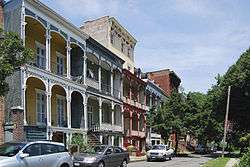
The neighborhoods of Albany[127][128] include Arbor Hill;[129] Center Square, "[an] eclectic mix of residential and commercial [buildings], including bars, night clubs, restaurants, and stores";[130] Pine Hills;[131] and the South End.[132]
Parks and recreation
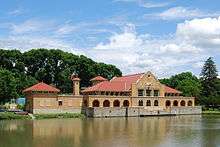
Albany has more than 60 public parks and recreation areas.[134] Washington Park was organized as the Middle Public Square in 1806. Its current location has been public property since the Dongan Charter of 1686 gave the city title to all property not privately owned. Washington Park was designed by John Bogart and John Cuyler in 1870,[135] and opened for public use the following year. The original lake house, designed by Frederick W. Brown, was added in 1876. The park had previously been used as a cemetery; its graves were moved to Albany Rural Cemetery. Washington Park is a popular place to exercise and play sports; skate during the winter; people-watch during Tulip Fest; and attend plays at the amphitheater during the summer.[135][136][137][138]
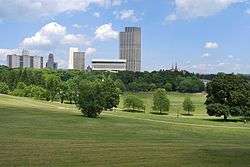
Other parks in Albany include Lincoln Park, Buckingham Park, the Corning Preserve, and the Pine Bush. Lincoln Park, southwest of the Empire State Plaza, was organized in 1886 and was originally known as Beaver Park.[139] Today, the park has a pool that is open during the summer months. Buckingham Lake Park is between Manning Boulevard and Route 85 in the Buckingham Pond neighborhood; it contains a pond with fountains, a footpath, a playground, and picnic tables.[140] The Albany Riverfront Park at the Corning Preserve has an 800-seat amphitheatre that hosts events in non-winter months, most notably the Alive at 5 summer concert series. The Preserve's visitors center details the ecology of the Hudson River and the local environment.[141] The park has a bike trail and boat launch[141] and was effectively separated from downtown by Interstate 787 until the opening of the Hudson River Way in 2002.[142]
Other public parks include Westland Hill Park, Hoffman Park, Beverwyck Park,[143] and Liberty Park, today a small circular grassy patch in downtown on Hudson Avenue, which is Albany's oldest park.[144] Ridgefield Park is home to the clay courts of the Albany Tennis Club, one of the oldest tennis clubs in the United States.[145] The municipal golf course, New Course at Albany, was constructed in 1929 as the Albany Municipal Golf Course, later renamed the Capital Hills at Albany, and remodeled in 1991.[146]
Architecture
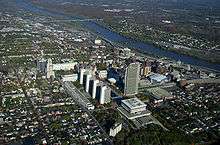
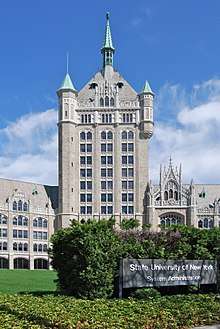
The Empire State Plaza, a collection of state agency office buildings, dominates almost any view of Albany. Built between 1965 and 1978 at the hand of Governor Nelson A. Rockefeller and architect Wallace Harrison, the complex is a powerful example of late American modern architecture[147] and remains a controversial building project both for displacing city residents and for its architectural style. The most recognizable aspect of the complex is the Erastus Corning Tower, the tallest building in New York outside of New York City.[147] Juxtaposed at the north end of the Plaza is the 19th-century New York State Capitol, the seat of the New York State Legislature and the home of the Governor's office.[148]
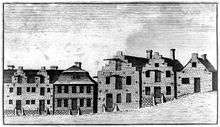
Albany's initial architecture incorporated many Dutch influences, followed soon after by those of the English.[149] Quackenbush House, a Dutch Colonial brick mansion, was built c. 1736;[150] Schuyler Mansion, a Georgian-style mansion, was built in 1765;[151] and the oldest building in Albany is the 1728 Van Ostrande-Radliff House at 48 Hudson Avenue.[152] Albany's housing varies greatly, with mostly row houses in the older sections of town, closer to the river. Housing type quickly changes as one travels westward, beginning with two-family homes of the late 19th century, and one-family homes built after World War II in the western end of the city.[153]
Albany City Hall, designed by Henry Hobson Richardson, was opened in 1883. The New York State Capitol was opened in 1899 (after 32 years of construction)[148] at a cost of $25 million, making it the most expensive government building at the time.[154] Albany's Union Station, a major Beaux-Arts design,[155] was under construction at the same time; it opened in 1900. In 1912, the Beaux-Arts styled New York State Department of Education Building opened on Washington Avenue near the Capitol. It has a classical exterior, which features a block-long white marble colonnade.[156] The 1920s brought the Art Deco movement, which is illustrated by the Home Savings Bank Building (1927) on North Pearl Street[157] and the Alfred E. Smith Building (1930) on South Swan Street,[158] two of Albany's tallest high-rises.[159]
Architecture from the 1960s and 1970s is well represented in the city, especially at the W. Averell Harriman State Office Building Campus (1950s and 1960s) and on the uptown campus of the University at Albany (1962–1971). The state office campus was planned in the 1950s by governor W. Averell Harriman to offer more parking and easier access for state employees.[160] The uptown SUNY campus was built in the 1960s under Governor Rockefeller on the site of the city-owned Albany Country Club. Straying from the popular open campus layout, SUNY Albany has a centralized building layout with administrative and classroom buildings at center surrounded by four student housing towers. The design called for much use of concrete and glass, and the style has slender, round-topped columns and pillars reminiscent of those at Lincoln Center in New York City.[161]
Downtown has seen a revival in recent decades, often considered to have begun with Norstar Bank's renovation of the former Union Station as its corporate headquarters in 1986.[lower-alpha 18] The Times Union Center (TU Center) was originally slated for suburban Colonie,[163] but was instead built downtown and opened in 1990.[164] Other development in downtown includes the construction of the State Dormitory Authority headquarters at 515 Broadway (1998);[165] the State Department of Environmental Conservation building, with its iconic green dome, at 625 Broadway (2001);[166] the State Comptroller headquarters on State Street (2001);[167] the Hudson River Way (2002), a pedestrian bridge connecting Broadway to the Corning Preserve;[142] and 677 Broadway (2005), "the first privately owned downtown office building in a generation".[168][169]
Demographics
City of immigrants
| Historical population | |||
|---|---|---|---|
| Census | Pop. | %± | |
| 1790 | 3,498 | — | |
| 1800 | 5,349 | 52.9% | |
| 1810 | 10,762 | 101.2% | |
| 1820 | 12,630 | 17.4% | |
| 1830 | 24,209 | 91.7% | |
| 1840 | 33,721 | 39.3% | |
| 1850 | 50,763 | 50.5% | |
| 1860 | 62,367 | 22.9% | |
| 1870 | 69,422 | 11.3% | |
| 1880 | 90,758 | 30.7% | |
| 1890 | 94,923 | 4.6% | |
| 1900 | 94,151 | −0.8% | |
| 1910 | 100,253 | 6.5% | |
| 1920 | 113,344 | 13.1% | |
| 1930 | 127,412 | 12.4% | |
| 1940 | 130,577 | 2.5% | |
| 1950 | 134,995 | 3.4% | |
| 1960 | 129,726 | −3.9% | |
| 1970 | 115,781 | −10.7% | |
| 1980 | 101,727 | −12.1% | |
| 1990 | 101,082 | −0.6% | |
| 2000 | 95,658 | −5.4% | |
| 2010 | 97,856 | 2.3% | |
| Est. 2019 | 96,460 | [6] | −1.4% |
| Sources: 1790–1950,[170] 1960–1980,[171] 1990–2000[172] | |||
Historically, Albany's population has been mixed. First dominated by Dutch and Germans, it was overtaken by the English in the early 19th century. Irish immigrants soon outnumbered most other ethnicities by the mid-19th century, and were followed by Italians and Poles. In the mid-to-late 20th century, the African-American population increased with thousands of people from the rural South, as part of the Great Migration. As historian (and Albany Assemblyman) John McEneny puts it,
Dutch and Yankee, German and Irish, Polish and Italian, black and Chinese—over the centuries Albany's heritage has reflected a succession of immigrant nationalities. Its streets have echoed with a dozen languages, its neighborhoods adapting to the distinctive life-style and changing economic fortunes of each new group.[173]
Until after the Revolution, Albany's population consisted mostly of ethnic Dutch descendants. Settlers migrating from New England tipped the balance toward British ethnicity in the early 19th century.[174] Jobs on the turnpikes, canals, and railroads attracted floods of Irish immigrants in the early 19th century, especially in the 1840s during the Irish potato famine, solidifying the city's Irish base. Albany elected its first Irish Catholic mayor (Michael Nolan) two years before Boston did.[175] Polish and Italian immigrants began arriving in Albany in the wave of immigration in the latter part of the 19th century. Their numbers were smaller than in many other eastern cities mainly because most had found manufacturing jobs at General Electric in Schenectady.[176] The Jewish community had been established early, with Sephardic Jewish members as part of the Beverwijck community. Its population rose during the late 19th century, when many Ashkenazi Jews immigrated from eastern Europe.[176] In that period, there was also an influx of Chinese and east Asian immigrants, who settled in the downtown section of the city. Many of their descendants have since moved to suburban areas.[177] Immigration plummeted after the Immigration Act of 1924.
Albany was also a destination of internal migration, as many African Americans moved north in their Great Migration from the rural South before and after World War I to fill industrial positions and find new opportunities. In the early years, they lived together with Italians, Jews and other immigrants in the South End, where housing was older and less expensive.[178] The black community has grown as a proportion of the population since then: African Americans made up 3 percent of the city's population in 1950, 6 percent in 1960, 12 percent in 1970, and 30 percent in 2010. The change in proportion is related mostly to middle-class white families moving to the suburbs, and black families remaining within city limits during the same time period.[7][172]
Since 2007 the number of Burmese refugees has increased, who are mostly of the Karen ethnicity; an estimated 5,000 reside in Albany as of January 2015.[179][180]
Modern overview
As of the 2010 census,[172] there were 97,856 people living in the city.[172] The population of the census area in 2009 was estimated to be 1,170,483.[9][18] The population density in 2010 was 4,572.7 per square mile (1,779.2/km2). There were 46,362 housing units at an average density of 2,166.4 per square mile (842.9/km2); 5,205 of these units (11.2%) were vacant. The racial makeup of the city residents was 52.3% white; 27% black or African American; 0.06% Native American or Native Alaskan; 7.4% Asian; 0.1% Native Hawaiian or Pacific Islander; .06% from other races; and 3.6% from two or more races. A total of 9.2% of the population were Hispanic or Latino of any race.[lower-alpha 19] Non-Hispanic Whites were 52.0% of the population in 2010,[108] compared to 87.0% in 1970.[181]
As of the 2000 census, the top five ancestry groups in the city were African (27%), Irish (18.1%), Italian (12.4%), German (10.4%), and English (5.2%); (33.1%) of the population reported "other ancestries". Albany is home to a Triqui language-speaking community of Mexican-Americans.[182][183]
The population had 20.0% under the age of 18, 19.3% from 18 to 24, 29.2% from 25 to 44, 18.1% from 45 to 64, and 13.4% who were 65 years of age or older. The median age was 31.4 years. For every 100 females, there were 90.6 males. For every 100 females age 18 and over, there were 86.5 males. Some 81.3% of the population had completed high school or earned an equivalency diploma.[172]
There were 40,709 households in 2000, out of which 22.0% had children under the age of 18 living with them, 25.3% were married couples living together, 16.1% had a female householder with no husband present, and 54.8% were non-families. 41.9% of all households were made up of individuals and 11.5% had someone living alone who was 65 years of age or older. The average household size was 2.11 and the average family size was 2.95.[172]
The median income for a household in the city in 2000 was $76,801, and the median income for a family was $79,708 (male, year-round worker) and $72,306 (female, year-round worker). The per capita income for the city was $58,752.[184][lower-alpha 20] About 16.0% of families and 21.7% of the population were below the poverty line, including 28.8% of those under age 18 and 12.5% of those age 65 or over.[172] The rate of reported violent crimes for 2008 (1,095 incidents per 100,000 residents) were more than double the rate for similarly sized US cities. Reported property crimes (4,669 incidents per 100,000 residents) were somewhat lower.[185][186]
Demographically speaking, the population of Albany and the Capital District mirrors the characteristics of the United States consumer population as a whole better than any other major municipality in the country. According to a 2004 study conducted by the Acxiom Corporation, Albany and its environs are the top-ranked standard test market for new business and retail products. Albany, Rochester, and Syracuse all scored within the top five.[187]
Culture
Nightlife and entertainment
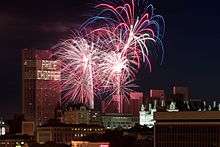
Albany's geographic situation—roughly equidistant between New York City to the south and Montreal to the north, as well as approximately 4.5 hours east of Buffalo, and 2.5 hours west of Boston—makes it a convenient stop for nationally touring artists and acts. The Palace Theatre and The Egg provide mid-sized forums for music, theater, and spoken word performances, with the Capital Repertory Theatre filling the small-sized niche.[189] The TU Center serves as the city's largest musical venue for nationally and internationally prominent bands. It also hosts trade shows, sporting events, and other large-scale community gatherings.[190] While some praise the cultural contributions of Albany and the greater Capital District,[96] others suggest the city has a "cultural identity crisis" due to its widespread geography, which requires a car (and driving time) to experience most of what the area has to offer, a necessity not seen in larger and more densely populated metropolitan areas such as New York and Boston.[191]
In recent years, the city's government has invested resources to cultivate venues and neighborhoods that attract after-hours business. Madison Avenue, Pearl Street, Delaware Avenue and Lark Street serve as the most active entertainment areas in the city. Many restaurants, clubs, and bars have opened since the mid-1990s, revitalizing numerous areas that had once been abandoned; various establishments have reclaimed old row houses, businesses, and even a pump station.[189] The bar scene generally incorporates three main strips. The downtown scene is focused on Pearl Street, stretching about two blocks. Up State Street, past the business district, is the Lark Street strip, home to smaller bars that fit into the neighborhood's artistic and eclectic style. Lastly, the midtown strip, with several bars on Western and Madison Avenues, centers around the campuses of the College of Saint Rose and SUNY Albany's downtown campus. The midtown strip generally draws a younger crowd, as it is popular to the local college students.[192]
Last call in Albany is 4:00 am nightly; New York law sets that time as last call throughout the state by default, and although counties may set an earlier time, individual municipalities may not. More than half of the state's counties have an earlier closing time, but Albany County, as with all counties in the Capital District, has retained the 4:00 am last call time.[193]
Festivals
Alive at 5 is a free, weekly concert series held downtown during the summer on Thursdays;[194] with 10 concerts in 2010, total attendance was roughly 100,000.[195] The Tulip Festival is set in Washington Park and celebrates the city's Dutch heritage. This traditional Albany event marks the beginning of spring as thousands of tulips bloom in the park in early May;[196] attendance to the Tulip Festival in 2010 was approximately 80,000.[195] Another large festival in Albany is the Capital Pride Parade and Festival, a major gay pride event held each June, attended by an estimated 30,000 spectators annually from across Upstate New York.[197]
The Price Chopper Fabulous Fourth and Fireworks Festival at the Empire State Plaza celebrates Independence Day with musical performances and the region's largest fireworks display.[188] Freihofer's Run for Women is a 5-kilometer run through the city that draws more than 4,000 participants from across the country; it is an annual event that began in 1978.[198]The Albany Chefs' Food & Wine Festival: Wine & Dine for the Arts is an annual Festival that hosts more than 3500 people over 3 days. The Festival showcases more than 70 Regional Chefs & Restaurants, 250 Global Wines & Spirits, a NYS Craft Beer Pavilion, 4 competitions (The Signature Chef Invitational, Rising Star Chef, Barista Albany and Battle of the Bartenders) and one Grand Gala Reception, Dinner & Auction featuring 10 f Albany's Iconic Chefs. The Albany Chefs' Food & Wine Festival donates all net proceeds to deserving Albany Arts Organizations and is held the Thursday-Saturday preceding Martin Luther King Weekend. Smaller events include the African American Family Day Arts Festival each August at the Empire State Plaza;[188] the Latin Fest, held each August at the Corning Preserve;[199] the Albany Jazz Festival, an annual end-of-summer event held at the Corning Preserve;[200] and Lark Fest, a music and art festival held each fall.[201]
Museums and historic sites
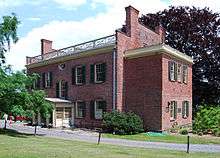
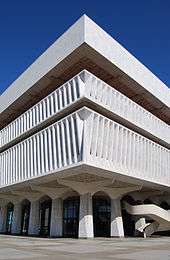
Because of Albany's historical and political significance, the city has numerous museums, historical buildings, and historic districts. Albany is home to the New York State Museum, the New York State Library and the New York State Archives; all three facilities are in the Cultural Education Center at the south end of Empire State Plaza and are free to the public.[203] The USS Slater (DE-766), a decommissioned World War II destroyer escort that was restored in 1998, is a museum ship docked in the Hudson River at Quay Street. It is the only ship of its kind still afloat.[204] The Albany Heritage Area Visitors Center, at the corner of Clinton Avenue and Broadway at Quackenbush Square, hosts a museum, gift shop, and the Henry Hudson Planetarium.[205] In early 2012, the Irish American Heritage Museum opened in downtown Albany. The museum is home to exhibits highlighting the contributions of the Irish people in America.[206]
The Albany Institute of History and Art, on Washington Avenue near the Center Square Neighborhood and State Capitol, is "dedicated to collecting, preserving, interpreting and promoting interest in the history, art, culture of Albany and the Upper Hudson Valley region." The museum's most notable permanent exhibits include an extensive collection of paintings by the Hudson River School and an exhibit on Ancient Egypt featuring the Institute's "Albany Mummies."
Albany is home to 57 listings on the National Register of Historic Places[207] (NRHP) and five National Historic Landmarks.[208] The Ten Broeck Mansion, a 1797 Federal-style mansion (later renovated in the Greek-Revival style) built for Abraham Ten Broeck (mayor of Albany 1779–1783 and 1796–1798)[209] is a historic house museum and the headquarters of the Albany County Historical Association;[202] it was added to the NRHP in 1971.[210] Later known as "Arbor Hill", it gave the current neighborhood its name.[211]
Literature and film
Albany has been the subject, inspiration, or location for many written and cinematic works. Many non-fiction works have been written on the city. One of the city's more notable claims to fame is Ironweed (1983), the 1984 Pulitzer Prize-winning book by Albany native William Kennedy. Ironweed was the third in a series of books by Kennedy known as the "Albany Cycle".[212][213] The elusive author Trevanian also grew up in Albany and wrote The Crazyladies of Pearl Street (2005), about a North Albany neighborhood along Pearl Street. The book is considered a semi-autobiographical memoir.[214]
In 1987, the film version of Ironweed premiered at the Palace Theatre.[215] The movie starred Jack Nicholson and Meryl Streep, each of whom were nominated for Academy Awards for their performances;[216] much of the filming was done on location in Albany.[215] Most recently the downtown area was the site of filming for the action-thriller Salt, starring Angelina Jolie,[217] and the action-comedy The Other Guys, starring Will Ferrell and Mark Wahlberg.[218]
Authors Herman Melville and Henry James lived with their families in Albany when young, before their careers. James identified his character Isabel Archer, the heroine of his novel The Portrait of a Lady, as being from Albany.[219] Gregory Maguire, author of Wicked: The Life and Times of the Wicked Witch of the West (adapted for the Broadway hit Wicked), grew up in North Albany[220] and graduated from SUNY Albany.[221]
Education
The City School District of Albany (CSDA) operates the city's public school system, which consists of 17 schools and learning centers;[222] in addition, there are 7 charter schools,[223] including Green Tech Charter High School,[224] and Albany Leadership High School.[225] [lower-alpha 21] In the 2015–2016 school year, over 9,000 students were enrolled in the public school system.[222] The district had an average class size of 18,[229] an 81-percent graduation rate,[lower-alpha 22] and a 5-percent dropout rate.[230] The district's 2010–11 budget is $202.8 million.[231] Although considered by the state to be one of the lowest-achieving high schools in New York, Albany High was listed as the nation's 976th best high school in a 2010 Newsweek/Washington Post report.[232] Albany also has a number of private schools, including the coed Bishop Maginn High School and Albany Free School; the all-boys Albany Academy;[lower-alpha 23] and the all-girls Academy of the Holy Names and Albany Academy for Girls.[234]
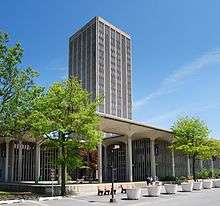
Albany has a prominent history in higher education and was ranked third in a Forbes survey called "The Best Places with the Best Education" in 2005;[236] it ranked top on Forbes' "IQ Campuses" list as part of its 150 Cheap Places to Live series in 2006.[237] The Albany Medical College (private), today part of Albany Medical Center, was founded in 1838. Albany Law School (private) is the oldest law school in New York and the fourth-oldest in the country; it was opened in 1851. President William McKinley was an alumnus. The Albany College of Pharmacy and Health Sciences (private) is the second-oldest pharmacy school in New York and the fifteenth-oldest in the United States.
The New York State Normal School, one of the oldest teachers colleges in the United States, opened in 1844; it was later known as the State Teachers College. It eventually evolved into the University at Albany, also known as SUNY Albany (public), which inherited the Normal School's original downtown campus on Western Avenue. The center of the campus moved to its current Uptown Campus in the west end of the city in 1970. SUNY Albany is a unit of the State University of New York and one of only four university centers in the system.[235] Other colleges and universities in Albany include Empire State College, The College of Saint Rose, Excelsior College, Maria College, Mildred Elley, and Sage College of Albany. Nearby Hudson Valley Community College (HVCC) fills the community college niche in the Albany-Troy area.[238] The effect of the campuses on the city's population is substantial: Combining the student bodies of all the aforementioned campuses (except HVCC) results in 63,149 students, or almost 70 percent of the 2008 estimate of Albany's permanent population.[239]
Economy
Albany's economy, along with that of the Capital District in general, is heavily dependent on government, health care, education, and more recently, technology. Because of these typically steady economic bases, the local economy has been relatively immune to national economic recessions in the past.[241] More than 25 percent of the city's population works in government-related positions.[242] Albany's estimated daytime population is more than 162,000. Companies based in Albany include Trans World Entertainment, AMRI Global and Clough Harbour. Albany has the fourth highest amount of lawyers in its employment pool (7.5 lawyers per 1,000 jobs) compared to the rest of the nation, behind Washington, D.C., Trenton, New Jersey, and New York City, respectively.[243]
Tech Valley
Since the 2000s, the economy of Albany and the surrounding Capital District has been redirected toward a high technology focus. Tech Valley is a marketing name for the eastern part of New York State, encompassing Albany, the Capital District, and the Hudson Valley.[244] Originated in 1998 to promote the greater Albany area as a high-tech competitor to regions such as Silicon Valley and Boston, it has since grown to represent the counties in the Capital District and extending to 19 counties from IBM's Westchester County plants in the south to the Canada–US border in the north. The area's high technology ecosystem is supported by technologically focused academic institutions including Rensselaer Polytechnic Institute and the State University of New York Polytechnic Institute.[245] Tech Valley encompasses 19 counties straddling both sides of the Adirondack Northway and the New York Thruway,[244] and with heavy state taxpayer subsidy, has experienced significant growth in the computer hardware side of the high-technology industry,[241] with great strides in the nanotechnology sector, digital electronics design, and water- and electricity-dependent integrated microchip circuit manufacturing.[246]
In 2012, the Albany-Schenectady area was listed fourth on Forbes Magazine's annual "Best Cities for Jobs" list, noting that job losses in state and local government were overcome by expansion of the high-tech field.[247]
Government
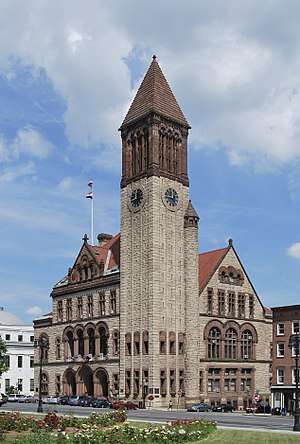
Albany has a mayor-council form of government, which functions under the Dongan Charter, which was granted by colonial governor Thomas Dongan in 1686 when Albany was incorporated as a city. A revised charter was adopted by referendum in 1998, but was legally reckoned as an amendment to the Dongan Charter. This gives Albany the distinction of having the oldest active city charter in the United States and "arguably the longest-running instrument of municipal government in the Western Hemisphere."[10][248] The mayor, who is elected every four years, heads the executive branch of city government.[249] The current mayor, Kathy Sheehan, was first elected in 2013. She replaced former mayor Gerald Jennings who was mayor for 20 years from 1994 to 2013.[250] The Common Council represents the legislative branch of city government and is made up of fifteen council members (each elected from one ward) and an at-large Common Council President.[248] The current president is Corey Ellis;[251] he began his term in January 2018.[252]
While Albany has its own city government, it has also been the seat of Albany County since the county's formation in 1683 and the capital of New York since 1797. As such, the city is home to all branches of the county and state governments, as well as its own. Albany City Hall sits on Eagle Street, opposite the State Capitol,[253] and the Albany County Office Building is on State Street.[254] The state government has offices scattered throughout the city.
Albany is in the 20th Congressional district, represented by Paul Tonko (D) in the United States House of Representatives. The city is represented by Chuck Schumer (D)[255] and Kirsten Gillibrand (D)[256] in the United States Senate. On the state level, the city is in the 44th district in the New York Senate, represented by Neil Breslin (D). In the New York Assembly, western Albany is in the 109th district, represented by Patricia Fahy (D) while downtown and eastern Albany are in the 108th district, represented by John T. McDonald III (D). As the seat of Albany County, the city is the location of the county's courts including Family Court, County Court, Surrogate Court, Supreme Court, and Court of Appeals.[257] Albany is the site of a United States district court for the Northern District of New York courthouse.[258]
Politics
Albany's politics have been dominated by the Democratic Party since the 1920s; Daniel (Uncle Dan) O'Connell established a political machine in the city with the election of William Stormont Hackett as mayor in 1922.[259] Prior to that, William Barnes Jr. had set up a Republican machine in the 1890s. Barnes' success is attributed to the fact that he owned two newspapers in Albany and that he was the grandson of Thurlow Weed, the influential newspaper publisher and political boss.[260] O'Connell's organization overcame Barnes' in 1922 and survived well into the 1980s (even after his death), as the machine put forth candidates for whom the electorate dutifully voted. In many instances, votes were outright bought;[261] it was not uncommon for the machine to "buy poor folks' loyalty and trust with a fiver".[262]
Gerald Jennings' upset in the 1993 Democratic mayoral primary over Harold Joyce, who had the Democratic Party's formal endorsement and had only recently been its county chairman, is often cited as the end of the O'Connell era in Albany.[263] Albany continues to be dominated by the Democratic party as enrollment in the city was 38,862 in 2009 compared to Republican enrollment of 3,487.[264] This gives Democrats a 10–1 advantage in the general election. Every elected city position has been held by a Democrat since 1931.[265]
In November 2013, Kathy Sheehan became the first woman to be elected Mayor of Albany.[266]
Religious life

Like most cities of comparable age and size, Albany has well-established Orthodox Christian, Roman Catholic, Protestant, and Jewish communities. Albany is home to the oldest Christian congregation in Upstate New York and the Mother Churches of two Christian dioceses. As of June 2010, eight churches or religious buildings in the city were listed on the National Register of Historic Places,[207] one of which—St. Peter's Episcopal Church on State Street—is a National Historic Landmark.[208]
Established in 1642,[268] the congregation of the First Church in Albany (Reformed), also known as the North Dutch Church (lon North Pearl Street), is the second-oldest Reformed Church in America.[267] The Cathedral of the Immaculate Conception (Eagle Street and Madison Avenue, built 1852) is the cathedral of the Roman Catholic diocese, led by Bishop Edward Scharfenberger,[269][270] and the Cathedral of All Saints (South Swan Street and Elk Street, built 1888) is the cathedral of the Episcopal diocese, led by Bishop William Love.[271][272] The city is home to eleven Catholic churches[273] and six Episcopal churches.[274]
A significant Jewish presence has existed in Albany as early as 1658,[275] and today includes many synagogues; there are two Conservative, a Chabad-Lubavitch, an Orthodox, and two Reform synagogues.[276] Albany is also home to one of the few Karaite synagogues outside Israel.[277] The city has a membership of between 12,000 and 13,000.[275]
Exact numbers on religious denominations in Albany are not readily available. Demographic statistics in the United States depend heavily on the United States Census Bureau, which cannot ask about religious affiliation as part of its decennial census.[278] It does compile some national and statewide religious statistics,[279] but these are not representative of a city the size of Albany. One report from 2000 offers religious affiliations for Albany County. According to the data, 59.2% of Albany County residents identified as Christian: 47% are Roman Catholic, 8.4% are mainline Protestants, 2.7% are Evangelical Protestants, and 1.1% are Eastern or Oriental Orthodox Christians. Residents who practice Judaism make up 4.2% of the population and Muslims represent 0.2%.[280] Note that these values are county-wide; city values could be significantly different.
Media
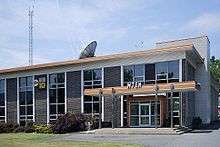
The Times Union is Albany's primary daily newspaper and the only one based close to the city; its headquarters moved from within city limits to suburban Colonie in the 1960s after a dispute with Mayor Corning over land needed for expansion.[281] Its circulation totals about 73,000 on weekdays and 143,000 on Sundays.[282] Serving Albany to a lesser degree are The Daily Gazette, based in Schenectady,[283] and The Record, of Troy.[284] Metroland is the alternative newsweekly in the area, publishing each Thursday,[285] while The Business Review is a business weekly published each Friday.[286] The Legislative Gazette, another weekly newspaper, focuses exclusively on issues related to the Legislature and the state government.[287]
The Albany-Schenectady-Troy media market is the 63rd-largest in the country in terms of radio[288] and the 57th-largest in terms of television audiences.[289] It is a broadcast market with historical significance. The pioneering influence of General Electric in Schenectady directly contributed to the area emerging as the birthplace of station-based television with WRGB; the station was also the first affiliate of NBC.[290] In 1947, the region was home to the first independently owned and operated commercial FM radio station in the United States: W47A.[290] WGY was the second commercial radio station in New York and the twelfth in the nation.[290] The Capital District is home to ABC affiliate WTEN 10,[291] CBS affiliate WRGB 6 (also operating CW affiliate WCWN 45),[292] Fox affiliate WXXA 23,[293] NBC affiliate WNYT 13 (also operating MyNetworkTV affiliate WNYA 51),[294] and PBS member station WMHT 17. Charter Communications hosts Spectrum News Capital Region, the area's only local 24-hour news channel.[295] The area has numerous radio stations.
Transportation
Highways
The Northway (Interstate 87 north of the New York State Thruway) connects Albany by car to Canada at Champlain; Autoroute 15 continues into Quebec, linking Albany to Montreal. Interstate 90 connects Albany to both Buffalo and Boston, via the New York State Thruway and the Massachusetts Turnpike respectively, both of which use I-90 (the NYS Thruway partially, the Massachusetts Turnpike fully). South of Albany, I-87 becomes part of the Thruway and ends at Interstate 278 in the Bronx. Albany is literally at the crossroad of I-87 and I-90, creating a junction between Buffalo and Boston, and Montreal and New York. Interstate 787 links Albany to Watervliet, Colonie, and Menands; by way of Route 7, I-787 connects to the Northway, offering Saratoga County residents a rather direct, albeit congested route to and from Albany during rush hour.[296]
Trains
With the closure of Union Station on Broadway, area passenger-rail service is provided by Amtrak at the Albany-Rensselaer station across the river in Rensselaer. In 2009, the station saw more than 720,000 passengers, making it Amtrak's second-busiest in New York, behind New York's Penn Station.[297] Amtrak provides service south to New York City; north to Montreal, and Rutland (Vermont); west to Niagara Falls, Toronto and Chicago; and east to Boston.
Airport
Albany's major airport is Albany International Airport in Colonie. Major airline service to Albany includes service by: American Airlines, Cape Air, Delta Air Lines, Southwest Airlines, JetBlue Airlines, and United Airlines; Million Air is the local fixed-base operator.[298] In 2010, Albany had the highest average airfare in New York, though the per-mile cost on its busiest routes was second-lowest in the state.[299]
Bus
The Capital District Transportation Authority (CDTA) provides bus service throughout Albany and the surrounding area, including Schenectady, Troy, and Saratoga Springs.[300] The city was once served by an urban streetcar service maintained by the United Traction Company. As in many American cities, after the advent of the automobile, light rail services declined in Albany and were replaced by bus and taxi services.[301] Greyhound Lines,[302] Trailways,[303] Peter Pan,[304] Short Line, Vermont Translines, and Yankee Trails[305] buses all serve a downtown terminal. Brown Coach provides commuter service.[306] Low-cost curbside bus service from the SUNY Albany campus and the Rensselaer station is also provided by Megabus, with direct service to New York City.
Boat
Albany, long an important Hudson River port, today serves domestic and international ships and barges through the Port of Albany-Rensselaer, on both sides of the river. The port has the largest mobile harbor crane in the state of New York.[308] The New York State Barge Canal, the ultimate successor of the Erie Canal, is in use today, largely by tourist and private boats.[309]
Sports
Albany has no major league professional sports teams, and minor league teams typically have low support.[312]
The Albany Devils were a minor league ice hockey team that moved to the city for the 2010–11 season. They played in the American Hockey League and were affiliated with the New Jersey Devils of the National Hockey League.[313][314] The Devils replaced the Albany River Rats, who played in the Capital Region from 1990 to 2010, when they relocated to Charlotte, North Carolina. The Albany Devils moved to Binghamton, New York in 2017.
The Albany Empire began play in the Arena Football League in 2018 and played at the Times Union Center through the 2019 season before the league folded. Previous teams include the Albany Firebirds who played in the AFL from 1990 to 2000 and a second team originally known as the Albany Conquest and later the Firebirds who played in af2, the AFL's developmental league, from 2002 to 2009.
The Tri-City ValleyCats short season minor league baseball team have played at the Joseph L. Bruno Stadium on the Hudson Valley Community College campus in North Greenbush since 2002. Prior to the ValleyCats' arrival, the Albany-Colonie Diamond Dogs (1995–2002) played at Heritage Park in Colonie; due to financial pressures, and facing impending competition from the ValleyCats, the franchise folded in 2002.[315]
The Albany Legends (International Basketball League), played in the Washington Avenue Armory from 2010 to 2014 before moving to Schenectady.[316] The Albany Patroons have played at the Armory on and off since 1982 and currently play in The Basketball League.[317]
With the large number of local colleges and universities around Albany, college sports are popular. The University at Albany's Great Danes play at the Division I level in all sports. The football team is a member of the Colonial Athletic Association while all other sports teams play as members of the America East Conference.[318] In 2006, UAlbany became the first SUNY-affiliated school to send a team to the NCAA Division I Men's Basketball Tournament.[319] The Siena Saints saw a rise in popularity after their men's basketball team made it to the NCAA Tournament in 2008, 2009, and 2010.[320] All 18 Saints teams are Division I and play in the Metro Atlantic Athletic Conference.[321] Although Siena's campus is in nearby Colonie, the men's basketball team plays at the Times Union Center.[310]
UAlbany has hosted the New York Giants training camp since 1996.[322]
Sister cities
Albany has five official sister city agreements and two other twin-city relationships. The city of Nijmegen, Netherlands connected with Albany following World War II. With the help of the Catholic university in Albany, the Catholic University of Nijmegen (Radboud University Nijmegen) rebuilt its partly destroyed library, with over 50,000 books being donated to the Dutch university. To show its gratitude for post-war assistance, the city sent Albany 50,000 tulip bulbs in 1948; this act led to the establishment of the annual Tulip Festival.[96] Most of the other connections were made in the 1980s during Mayor Whalen's term in office as part of his cultural expansion program.[96] The official sister cities are:[323]
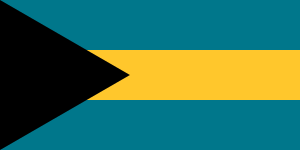

.svg.png)


The additional twin-city relationships are with:[96]
.svg.png)

See also
Notes
- For the area code.
- MSN Encarta states that this nickname "resulted from the meeting here in 1754 of the Albany Congress, which adopted Benjamin Franklin's Plan of Union, the first formal proposal to unite the colonies.[1]
- In this instance, assiduity, "the quality of acting with constant and careful attention."[2]
- On Birch Hill Road near Loudonville Reservoir.
- Mean water elevation, varies with the tide.[5]
- The Dongan Charter incorporated Albany three months after New York City's charter was ratified. However, the latter forfeited its charter during Leisler's Rebellion, making Albany's the oldest effective charter in the country.[15][16]
- This name would later be adopted by the city of Schenectady, to the west.[19]
- James Stuart (1633–1701), brother and successor of Charles II, was both the Duke of York and Duke of Albany before being crowned James II of England and James VII of Scotland in 1685. His title of Duke of York is the source of the name of the province of New York.[27]
- The Plan of Union's original intention was to unite the colonies in defense against aggressions of the French to the north; it was not an attempt to become independent from the auspices of the British crown.[38]
- A rough grid pattern was established in 1764, aligning the streets with Clinton Avenue, which marked the northern border of Albany at the time. Patroon of the Manor of Rensselaerswyck Stephen Van Rensselaer II followed the same directional system north of Clinton Avenue on his lands; however, the two systems were not related otherwise, which is why cross streets north and south of Clinton Avenue do not align. The stockade surrounding the city was taken down shortly before the Revolutionary War, allowing for expansion. De Witt, city surveyor at the time, continued the grid pattern to the west and renamed on his 1794 map any streets that had honored British Royalty. Hawk Street is the only road that retained its original name; the rest were renamed after birds and mammals.[46][47]
- "The Colonie" made up the current area of Arbor Hill and was the more urban part of the Manor of Rensselaerswyck, which surrounded Albany.[52] It is the source of the name of the current town and village of Colonie.[53]
- Grondahl summarizes it as, "This hard-line position of isolationism on the part of the machine was a curse economically – but a strange blessing unintentionally in architectural terms. While downtown went to seed and plans for large-scale construction and improvements came to a virtual standstill in Albany without federal money, pockets of the city's historic housing stock escaped the wrecking ball."[86]
- The Empire State Plaza was originally known as the South Mall; the South Mall Arterial is the only remnant of that naming scheme.
- For example, the Plaza has four traffic tunnels, two intended for through traffic, and two for local traffic (only the outer, local traffic tunnels are in use); the Arterial ends abruptly between Jay Street and Hudson Avenue just west of South Swan Street (42°39′6.17″N 73°45′43.54″W); the east end of the Dunn Memorial Bridge ends abruptly in Rensselaer (42°38′33.33″N 73°44′44.78″W); and Henry Johnson Boulevard, which would have extended as part of the Mid-Crosstown Arterial, ends abruptly at Livingston Avenue (42°39′49.92″N 73°45′30.58″W).
- Mean monthly maxima and minima (i.e. the expected highest and lowest temperature readings at any point during the year or given month) calculated based on data at said location from 1981 to 2010.
- According to the National Weather Service, the snowfall data has been readjusted as of June 3, 2015. As such, snowfall data is based the source at Albany Snowfall Normals
- Official records for Albany kept January 1874 to May 1938 at downtown and at Albany Int'l since June 1938. For more information, see Threadex
- In 2009, Bank of America (which now owns FleetBank, the bank that eventually bought Norstar) consolidated its operations in an office building on State Street, leaving the former train station vacant.[162] Mayor Corning made great efforts to save the building, which had been owned by his great-grandfather's railroad a hundred years before. He was able to do it when governor Rockefeller brought state money in to purchase the building.[91]
- The percentages listed here were calculated using the raw population data given by the Census Bureau divided by the total population, rounded to the nearest hundredth. Note that these percentages were calculated using the total population value of 97,856 as the divisor, not the 94,233 people claiming one race.[172]
- These values were given in 1999 dollars; here they have been adjusted for inflation.[172]
- Albany was once home to 12 charter schools[226] until the closing of New Covenant Charter School in 2010.[227] It was announced in July 2010 that the Harriet Gibbons High School, an alternative high school for at-risk ninth graders, would close after a negative report from the State Department of Education demanded the elimination of ineffective programs.[228]
- The Accountability and Overview Report[229] puts the class of 2009 at 513 students and the Comprehensive Information Report[230] states that 416 of them graduated.
- Christian Brothers Academy was located in various Albany locations throughout the 19th century and then moved to the University Heights neighborhood in 1937. The school moved out of the city to Colonie in 1998 and has remained there since.[233]
References
- "Albany" Archived October 29, 2009, at the Wayback Machine. Archived October 31, 2009.
- Nearing, Brian. Three Cheers for the Orange, White, and Blue. Times Union (Albany). November 30, 2004 [archived January 12, 2013; Retrieved August 3, 2010]:B1. Hearst Newspapers.
- "2019 U.S. Gazetteer Files". United States Census Bureau. Retrieved July 27, 2020.
- "Worldwide Elevation Finder". elevation.maplogs.com.
- "NATIONAL WATER QUALITY ASSESSMENT PROGRAM - The Hudson River Basin". USGS. Retrieved March 2, 2020.
- "Population and Housing Unit Estimates". United States Census Bureau. May 24, 2020. Retrieved May 27, 2020.
- McEneny (2006), p. 111
- "Distance from Albany, NY to New York, NY". check-distance.com. Retrieved February 14, 2019.
- "Archived copy". Archived from the original on September 13, 2015. Retrieved 2015-11-09.CS1 maint: archived copy as title (link)
- Fitzpatrick, Edward. 312-Year-Old Document Shapes City's Government. Times Union (Albany). June 3, 1998 [archived January 11, 2013; Retrieved May 23, 2010]:B4. Hearst Newspapers.
- McEneny (2006), p. 201
- Rulison, Larry (July 10, 2015). "Made in Albany: IBM reveals breakthrough chip made at SUNY Poly". Albany Times-Union. Retrieved July 12, 2015.
- Klopott, Freeman; Wang, Xu; Ring, Niamh (September 27, 2011). "IBM, Intel Start $4.4 Billion in Chip Venture in New York". Bloomberg. Retrieved July 12, 2015.
- Larnard, J.N. In: Donald E. Smith. The New Larned History for Ready Reference and Research. Vol. I (A-Bak). C.A. Nichols Publishing Company; 1922. p. 195.
- League, National Municipal (1896). "Proceedings of the Conference for Good City Government and the Annual ..."
- "Albany Guide Book". 1917.
- McEneny (2006), p. 6
- Howell, George Rogers (1886). Bi-centennial History of Albany. W. W. Munsell & Company. p. 460.
- Notes on the Iroquois; Or, Contributions to American History, Antiquities, and General Ethnology. Albany, New York: Erastus H. Pease & Co; 1847. p. 345.
- Cuyler Reynolds, Albany Chronicles, 1906, pg. 28 https://books.google.com/books/reader2?id=XNU0AAAAIAAJ&printsec=frontcover&output=reader&pg=GBS.PA2.w.5.0.0
- Henry Hudson. (2010). Encyclopædia Britannica. Retrieved June 27, 2010, from Encyclopædia Britannica Online.
- Howell, George Rogers (1886). "Bi-centennial History of Albany".
- Venema (2003), p. 13
- Rittner (2002), p. 7
- Venema (2003), p. 12
- James Wesley Bradley, Before Albany: An Archaeology of Native-Dutch Relations in the Capital Region 1660-1664 Archived December 23, 2014, at the Wayback Machine, Albany: University of the State of New York, 2007, pp. 2-6
- Brodhead, John Romeyn (1874). History of the State of New York. Harper & Brothers. p. 744.
- Encyclopædia Britannica Eleventh Edition (Albany, Dukes of). Encyclopædia Britannica Company; 1910. OCLC 197297659. p. 487.
- In: E.G. Cody. The Historie of Scotland. Edinburgh: William Blackwood and Sons; 1888. OCLC 3217086. p. 354.
- "Albany Chronicles". 1906.
- Thorne, Kathryn Ford, Compiler & Long, John H., Editor: New York Atlas of Historical County Boundaries; The Newbury Library; 1993.
- A Map of the Provinces of New-York and New-Jersey, with a Part of Pennsylvania and the Province of Quebec (Map). ca. 1:1,040,000. Cartography by Claude Joseph Sauthier. Matthew Albert Lotter. 1777.
- French, John Homer (1860). Gazetteer of the State of New York. R. Pearsall Smith. p. 155.
- New York State Museum. The Dongan Charter [Retrieved November 23, 2008].
- "Albany Chronicles". 1906.
- New York State Museum. How a City Worked: Occupations in Colonial Albany [archived November 20, 2008; Retrieved January 10, 2009].
- Rittner (2002), p. 22
- McEneny (2006), p. 12
- McEneny (2006), p. 56
- New York State Museum. The Committee of Correspondence; March 8, 2010 [Retrieved August 19, 2010].
- United States Congress. Livingston, Philip (1716–1778) [Retrieved October 9, 2009].
- Landmarks of Rensselaer county, New York. archive.org. Syracuse, N.Y., D. Mason & company. 1897.
- Gerlach, Don R. (1977). "Black Arson in Albany, New York: November 1793". Journal of Black Studies. 7 (3): 301–312. doi:10.1177/002193477700700304. JSTOR 2783709.
- The Magazine of American History with Notes and Queries. Historical Publication Co; 1886. p. 24.
- Rittner (2002), back cover
- Waite (1993), p. 185
- McEneny (2006), p. 68
- McEneny (2006), p. 75
- Waite (1993), p. 201
- McEneny (2006), p. 92
- U.S. Bureau of the Census. Population of the 46 Urban Places: 1810; June 15, 1998 [Retrieved July 14, 2010].
- City of Albany Department of Urban Redevelopment. Appendix: Annexations 1815–1967 [archived August 23, 2008; Retrieved September 11, 2010].
- Town of Colonie. Colonie History: Frequently Asked Questions; June 19, 2008 [archived September 23, 2010; Retrieved September 11, 2010].
- Andrews, Horace (1895). City of Albany (Map). 1 inch per 1000 feet. Julius Bien & Company.
- The People's Welfare: Law and Regulation in Nineteenth-Century America. Chapel Hill: The University of North Carolina Press; 1996. ISBN 0-8078-4611-2. p. 139.
- New York State Historical Association. New York: A Guide to the Empire State. New York City: Oxford University Press; 1940. OCLC 504264143. p. 727.
- Joseph Henry [archived December 9, 2006; Retrieved September 18, 2010].
- Joseph Henry. (2010). Encyclopædia Britannica. Retrieved September 18, 2010, from Encyclopædia Britannica Online.
- Gibson, Campbell. U.S. Bureau of the Census. Population of the 90 Urban Places: 1830; June 15, 1998 [Retrieved July 14, 2010].
- Gibson, Campbell. U.S. Bureau of the Census. Population of the 100 Urban Places: 1840; June 15, 1998 [Retrieved July 14, 2010].
- Gibson, Campbell. U.S. Bureau of the Census. Population of the 100 Urban Places: 1850; June 15, 1998 [Retrieved July 14, 2010].
- Gibson, Campbell. U.S. Bureau of the Census. Population of the 100 Largest Cities and Other Urban Places in the United States: 1790 to 1990; June 15, 1998 [Retrieved July 14, 2010].
- Pennsylvania RR Chronology; 2005 [Retrieved June 2, 2010]; p. 5.
- Waite (1993), p. 245
- The Railroad Builders, A Chronicle of the Welding of the States. Yale University Press; 1921. p. 27.
- Anderson, Eric. For a glimpse of the future, backtrack. Times Union (Albany). June 17, 2010 [archived April 30, 2011; Retrieved June 17, 2010]. Hearst Newspapers.
- New York State Department of Transportation. History of Railroads in New York State [archived December 14, 2012; Retrieved June 4, 2010].
- Shaughnessy, Jim (1997) [1982]. Delaware & Hudson. Syracuse, NY: Syracuse University Press. p. 89. ISBN 0-8156-0455-6. OCLC 36008594.
- The Albany Lumber Trade: Its History and Extent. Albany: The Argus Company; 1872. OCLC 8260640. p. 7.
- United States Congress. Nolan, Michael Nicholas [Retrieved June 30, 2010].
- McEneny (2006), pp. 87–88
- McEneny (2006), p. 88
- McEneny (2006), pp. 88 & 92
- McEneny (2006), p. 65
- New York State Museum. The Bank of Albany; January 6, 2008 [Retrieved July 19, 2010].
- No author listed. Trust(Co) Worth Advice?. Times Union (Albany). June 10, 2007 [archived April 30, 2011; Retrieved July 19, 2010]:C1. Hearst Newspapers.
- No author listed. KeyCorp. Times Union (Albany). November 10, 2008 [archived April 30, 2011; Retrieved July 19, 2010]:C8. Hearst Newspapers.
- Gordon, Marcy. Bank Merger Clears Last Hurdle. Times Union (Albany). March 9, 2004 [archived April 30, 2011; Retrieved July 19, 2010]:E1. Hearst Newspapers.
- "Albany Chronicles". 1906.
- Howell, George Rogers (1886). "Bi-centennial History of Albany".
- Laws of the State of New York, Passed at the Ninety-Third Session of the Legislature, Begun January Fourth, and Ended April Twenty-Sixth, 1870, in the City of Albany. Volume I. State of New York/Weed, Parsons and Company; 1870 [Retrieved September 11, 2010]. p. 412.
- Laws of the State of New York, Passed at the Ninety-Fourth Session of the Legislature, Begun January Third, and Ended April Twenty-first 1871, in the City of Albany. Volume II. State of New York/The Argus Company; 1871 [Retrieved September 11, 2010]. p. 1688.
- Town of Bethlehem. Cutting Ice: Big Business in Bethlehem [archived October 6, 2010; Retrieved September 11, 2010].
- McEneny (2006), p. 157
- Grondahl (2007), p. 490
- Grondahl (2007), p. 500
- Grondahl (2007), p. 494
- Grondahl (2007), p. 492
- Albany International Airport. Albany Airport History [archived December 22, 2008; Retrieved June 2, 2010].
- Grondahl (2007), p. 501
- Grondahl (2007), p. 502
- Grondahl (2007), pp. 467–469
- Grondahl (2007), p. 498
- Jordan, Christopher. Capital Highways. Mid-Crosstown Arterial; 2006 [archived April 29, 2011; Retrieved June 28, 2010].
- McEneny (2006), p. 191
- McEneny (2006), p. 192
- Pace, Eric. Thomas M. Whalen III, 68, Three-Term Mayor of Albany (Obituary). March 8, 2002 [Retrieved July 18, 2010]. The New York Times.
- McEneny (2006), p. 193
- McEneny (2006), pp. 193–194
- McEneny (2006), p. 198
- "J.P. Morgan Chase & Co. - Albany, 12 Corporate Woods Boulevard, 4th Floor, Albany, 122112344 | Search Albany Businesses at Albany.com". Albany.com. Retrieved November 9, 2015.
- "Albany, NY - Merrill Lynch Branch Office". www.ml.com. Retrieved November 9, 2015.
- "CGI offices". CGI.com. Retrieved August 27, 2016.
- "Ayco". www.ayco.com. Retrieved November 9, 2015.
- Reynolds, Cuyler (1906). Albany Chronicles. J. B. Lyon Company, printers. p. 603. Retrieved January 18, 2009.
castle island french fort 1540.
- "A Short History of International Paper" (PDF). Forest History Today. Archived from the original (PDF) on March 26, 2009. Retrieved April 30, 2009.
- National Civic League. All America City Awards: AAC Winners by State and City; 2010 [Retrieved September 6, 2010].
- United States Census Bureau. State & County QuickFacts: Albany (city); January 2, 2008 [archived February 17, 2010; Retrieved July 17, 2010].
- New York: Albany Quadrangle (15-Minute Series) (Map). United States Geological Survey. 1950. Archived from the original on August 1, 2010. Retrieved June 14, 2010.
- New York State Museum. Foxes Creek; October 10, 2007 [Retrieved May 24, 2010].
- New York State Museum. Beaverkill [Retrieved May 24, 2010].
- New York State Museum. Ruttenkill; July 29, 2001 [Retrieved May 24, 2010].
- Save the Pine Bush. Virtual Exhibit; January 12, 2008 [Retrieved June 14, 2010].
- National Water Quality Assessment Program. United States Geological Survey. The Hudson River Basin; December 16, 2009 [Retrieved October 10, 2010].
- The Hudson River Estuary. New York City: Cambridge University Press; 2006. ISBN 0-521-84478-9. p. 3.
- Burger (2006), pp. 27–36
- Burger (2006), p. 58
- World Map of Köppen–Geiger Climate Classification. Meteorologische Zeitschrift. June 2006;15(3):261. doi:10.1127/0941-2948/2006/0130.
- United States Department of Agriculture. United States National Arboretum. USDA Plant Hardiness Zone Map [archived March 3, 2015; Retrieved June 14, 2010].
- "Station Name: NY ALBANY AP". National Oceanic and Atmospheric Administration. Retrieved September 10, 2016.
- Scruton, Bruce A.. It's Winter, So Warm Up to It. Times Union (Albany). January 18, 2005 [archived April 30, 2011; Retrieved September 6, 2010]:B1. Hearst Newspapers.
- "NowData - NOAA Online Weather Data". National Oceanic and Atmospheric Administration. Retrieved February 25, 2017.
- "WMO Climate Normals for ALBANY/ALBANY COUNTY, NY 1961–1990". National Oceanic and Atmospheric Administration. Retrieved March 10, 2014.
- d.o.o, Yu Media Group. "Albany, NY - Detailed climate information and monthly weather forecast". Weather Atlas. Retrieved June 29, 2019.
- "FBI releases crime rates for New York State". CNY Central. September 14, 2010. Archived from the original on July 23, 2014. Retrieved July 15, 2014.
- "FBI — Table 4 - Montana through Ohio". FBI.
- "Albany's Neighborhoods". City of Albany. Retrieved July 6, 2010.
- "Albany NY Neighborhoods: Mansion, Pine Hills, Center Square & More". www.albany.com.
- Grondahl, Paul (October 1, 2014). "Arbor Hill named one of America's 10 great neighborhoods". Times Union.
- https://www.bizjournals.com/albany/news/2017/10/13/a-guide-to-the-coolest-places-to-live-eat-and-play.html#g/421163/1
- "How can troubles in Albany's student ghetto be fixed?". Times Union. March 27, 2011.
- Moench, Mallory (December 30, 2018). "South End community vigor aims to revive Albany neighborhood". Times Union.
- Waite (1993), pp. 158–159
- "Park Maintenance". City of Albany, New York. Archived from the original on June 14, 2008. Retrieved July 4, 2010.
- Waite (1993), p. 155
- Howell, George Rogers; Tenney, Jonathan (1886). Bi-centennial History of Albany. W. W. Munsell & Company. p. 517.
- Brooke, Cornelia E. (May 1972). "Washington Park Historic District". New York State Office of Parks, Recreation and Historic Preservation. Archived from the original on October 12, 2012. Retrieved June 1, 2010.
- "Chronological History of Washington Park". Washington Park Conservancy. Retrieved June 1, 2010.
- "Lincoln Park". Washington Park Conservancy. Retrieved June 3, 2010.
- Lisi, Michael. Buckingham Pond, Albany. Times Union (Albany). July 22, 2007 [archived April 30, 2011; Retrieved July 4, 2010]. Hearst Newspapers.
- "Albany Riverfront Park at the Corning Preserve". City of Albany, New York. Archived from the original on October 7, 2006. Retrieved July 4, 2010.
- Albany County Convention & Visitors Bureau. Hudson River Way [archived September 28, 2007; Retrieved June 15, 2010].
- "Playgrounds and Recreational Facilities" (PDF). City of Albany Recreation Office. 2010. Retrieved July 4, 2010.
- Huey, Paul R (2002). The Patroon's Garden and Liberty Park, Albany, New York. Waterford: New York State Office of Parks, Recreation and Historic Preservation. OCLC 77589030.
- Abukhalaf, Jackie. "Albany Tennis Club in full swing". Times Union. Retrieved November 17, 2016.
- Bryant, Eric (2003). Bogies and Billygoats: A History of the Albany Municipal Golf Course. Writer's Club Press. p. 6. ISBN 9780595264506.
- Waite (1993), pp. 81–82
- Waite (1993), pp. 68–70
- Scheltema, Gajus and Westerhuijs, Heleen (eds.),Exploring Historic Dutch New York. Museum of the City of New York/Dover Publications, New York 2011
- National Register of Historic Places Inventory/Nomination: Quackenbush House; February 4, 1972 [archived April 29, 2011; Retrieved May 22, 2010].
- Waite (1993), pp. 48–49
- Grondahl, Paul. This Old House Under Our Noses. Times Union (Albany). December 23, 2008 [archived July 1, 2012; Retrieved July 5, 2010]. Hearst Newspapers.
- Scruton, Bruce A. City's Architectural Heritage Diverse, Extensive. Knickerbocker News. July 6, 1986 [archived April 30, 2011; Retrieved July 2, 2010]:T52. Hearst Newspapers (online publisher).
- Public Broadcasting Service. Building Big: New York State Capitol; 2001 [Retrieved June 19, 2010].
- Waite (1993), p. 106
- Waite (1993), pp. 79–80
- Waite (1993), p. 98
- Waite (1993), p. 82
- Emporis. Albany: Buildings of the City [Retrieved June 9, 2010].
- Dirt, Not Ivy, Covers This Campus. Times Union (Albany). September 28, 1997 [archived April 30, 2011; Retrieved May 22, 2010]:A1. Hearst Newspapers.
- Waite (1993), pp. 241–242
- Churchill, Chris. A Landmark Soon to Fall Empty. Times Union (Albany). October 21, 2009 [archived April 30, 2011; Retrieved June 28, 2010]. Hearst Newspapers.
- McEneny (2006), p. 194
- McKeon, Michael. The Knick: Post-Debut Review Despite Glitches, Arean Withstands First Night. Times Union (Albany). February 1, 1990 [archived April 30, 2011; Retrieved June 28, 2010]:B1. Hearst Newspapers.
- Benjamin, Elizabeth. DEC Firms Up Plans for Tower. Times Union (Albany). February 4, 1999 [archived April 30, 2011; Retrieved May 22, 2010]:B7. Hearst Newspapers.
- Cappiello, Dina. Workers, DEC Tussle Over Office. Times Union (Albany). September 2, 2001 [archived April 30, 2011; Retrieved May 21, 2010]:D3. Hearst Newspapers.
- Woodruff, Cathy. New Kid on the Block Stands Tall Amid Neighbors. Times Union (Albany). January 1, 2002 [archived April 30, 2011; Retrieved June 18, 2010]:B1. Hearst Newspapers.
- Barnes, Steve. Eat, drink, be merry. Now what?. Times Union (Albany). October 8, 2006 [archived April 30, 2011; Retrieved July 7, 2010]:A1. Hearst Newspapers.
- BBL Development Group. Completed Projects [archived May 18, 2007; Retrieved July 7, 2010].
- United States Census Bureau. 1950 Census of Population; Volume 1: Characteristics of the Population; 1950 [Retrieved September 6, 2010]; p. 32-8 (64 in PDF file).
- 1980 Census of Population; Volume 1: Characteristics of the Population. United States Census Bureau; 1980 [Retrieved September 6, 2010]. p. 34-10.
- "U.S. Census website". United States Census Bureau. Retrieved 2008-01-31.
- McEneny (2006), p. 102
- McEneny (2006), p. 103
- McEneny (2006), p. 104
- McEneny (2006), p. 107
- McEneny (2006), p. 108
- Lemak, Jennifer A. "Albany, New York and the Great Migration", Afro - Americans in New York Life and History, Vol. 32, Iss. 1, (Jan 2008): 47-74
- McKibben, Matthew (January 12, 2015). "Albany's Karen community celebrates New Year". The Daily Gazette. Retrieved November 23, 2015.
- Grondahl, Paul (March 9, 2013). "They nail the American Dream". Times Union (Albany). Retrieved November 23, 2015.
- "New York - Race and Hispanic Origin for Selected Cities and Other Places: Earliest Census to 1990". U.S. Census Bureau. Archived from the original on August 12, 2012. Retrieved May 12, 2012.
- Claudio Torrens (May 28, 2011). "Some NY immigrants cite lack of Spanish as barrier". UTSanDiego.com. Retrieved February 10, 2013.
- Carleo-Evangelist, Jordan (April 14, 2014). "Keeping a language alive: Dictionary project aims to save native tongue of the Triqui community". Times Union (Albany). Retrieved June 4, 2016.
- Federal Bureau of Investigation. Uniform Crime Reports: Table 6 Crime in the United States by Metropolitan Statistical Area, 2008 [archived August 23, 2010; Retrieved September 8, 2015].
- Federal Bureau of Investigation. Uniform Crime Reports: Table 6 Crime in the United States by Metropolitan Statistical Area, 2008 [archived August 23, 2010; Retrieved September 8, 2010].
- Federal Bureau of Investigation. Uniform Crime Reports: Table 16 Crime in the United States by Metropolitan Statistical Area, 2008 [archived August 18, 2010; Retrieved September 8, 2010].
- Paeth, Greg. Cincinnati Among Top 20 at Average: N.Y. Cities Head Test Market List. The Cincinnati Post. June 3, 2004 [archived March 12, 2007; Retrieved June 6, 2010]. E. W. Scripps Company.
- "OGS Announces at the Plaza Summer Concert and Festival Dates" (PDF) (Press release). New York State Office of General Services. June 17, 2010. Archived from the original (PDF) on July 2, 2010. Retrieved June 22, 2010.
- Furfaro, Danielle T. City Bringing the Fun Downtown. Times Union (Albany). September 3, 2000 [archived April 30, 2011; Retrieved July 19, 2010]:B3. Hearst Newspapers.
- DeMare, Carol. The New Center of Attention. Times Union (Albany). December 31, 2006 [archived April 30, 2011; Retrieved July 19, 2010]:E1. Hearst Newspapers.
- Janairo, Michael. Big Picture: The Arts in Our Daily Lives. Times Union (Albany). June 21, 2010 [Retrieved July 27, 2010]. Hearst Newspapers.
- Best Western Sovereign Hotel. Albany New York Nightlife; January 4, 2011 [Retrieved January 4, 2011].
- Barnes, Steve. City urges bar owners to have last call earlier. Times Union (Albany). January 4, 2011 [archived April 30, 2011; Retrieved March 31, 2010]:B1. Hearst Newspapers.
- City of Albany Office of Special Events & Volunteer Services. Events: Alive at 5 [Retrieved June 22, 2010].
- Department of General Services. "Department of General Services 2010 Yearly Message" (PDF). City of Albany, New York. p. 2.
- City of Albany Office of Special Events & Volunteer Services. Events: Tulip Festival [Retrieved June 22, 2010].
- Andrew Collins (July 7, 2017). "Capital Gay Pride Festival in Albany, NY". tripsavvy. Retrieved December 21, 2017.
- USATF Adirondack Association, Inc. Women's 5K Run [archived March 28, 2010; Retrieved July 18, 2010].
- O'Brien, Tim. This Fest Did Not Rest. Times Union (Albany). August 30, 2009 [archived April 30, 2011; Retrieved June 22, 2010]:C1. Hearst Newspapers.
- City of Albany Office of Special Events & Volunteer Services. Events: Jazz Festival [Retrieved June 22, 2010].
- Mannix Marketing, Inc. LarkFEST 2010 [Retrieved June 22, 2010].
- Albany County Historical Association. Historic Ten Broeck Mansion [Retrieved July 9, 2010].
- "Directions, parking and visitor information for the Cultural Education Center, Albany, NY". nysed.gov. Archived from the original on March 23, 2015.
- Destroyer Escort Historical Museum. USS Slater History; July 9, 2002 [archived May 23, 2010; Retrieved July 2, 2010].
- Albany County Convention & Visitors Bureau. Albany Heritage Area Visitors Center [archived April 4, 2009; Retrieved July 12, 2010].
- "About the Irish American Heritage Museum". Irish American Heritage Museum. Archived from the original on February 11, 2012. Retrieved September 23, 2012.
- National Park Service, United States Department of the Interior. National Register of Historic Places: Weekly List Actions; June 18, 2010 [Retrieved June 19, 2010].
- National Park Service. U.S. Department of the Interior. National Historic Landmarks Survey: Database [archived June 6, 2004; Retrieved September 6, 2010].
- New York State Museum. Abraham Ten Broeck; December 15, 2008 [archived June 21, 2010; Retrieved July 9, 2010].
- New York State Office of Parks, Recreation and Historic Preservation. National Register of Historic Places Inventory/Nomination: Ten Broeck Mansion; August 1970 [archived April 29, 2011; Retrieved July 10, 2010].
- Keeney, Irene Gardner. Hearst Newspapers. Historic Arbor Hill's Changing Fortunes; August 3, 1986 [archived July 20, 2012; Retrieved July 10, 2010]; p. G1.
- Grondahl, Paul. Kennedy Pleased to Accept Fitzgerald Award. Times Union (Albany). October 11, 2007 [archived April 30, 2011; Retrieved July 25, 2010]:D7. Hearst Newspapers.
- Lehmann-Haupt, Christopher. Books of the Times. New York Times. January 10, 1983 [Retrieved July 25, 2010]. New York Times Company.
- Gravity Publishing. Trevanian Books/The Crazyladies of Pearl Street [Retrieved July 25, 2010].
- Grondahl, Paul. At Last, 'Ironweed' Plays the Palace. Times Union (Albany). December 18, 1987 [archived April 30, 2011; Retrieved July 25, 2010]:A1. Hearst Newspapers.
- Academy of Motion Picture Arts and Sciences. The Official Academy Awards Database [archived February 8, 2009; Retrieved July 25, 2010].
- Karlin, Rick. Lights, Camera, Detour. Times Union (Albany). April 22, 2009 [archived April 30, 2011; Retrieved July 25, 2010]:A1. Hearst Newspapers.
- Churchill, Chris. Bright Lights, Our City. Times Union (Albany). October 8, 2009 [archived April 30, 2011; Retrieved July 25, 2010]:C1. Hearst Newspapers.
- Lane, Anthony. "Out of the Frame". The New Yorker. Condé Nast. Retrieved August 18, 2016.
- Hearst Newspapers. Albany Book Festival Showcases Power of Storytelling; April 11, 2010 [Retrieved July 25, 2010].
- University at Albany, State University of New York. Inspiring Students: Maguire Explores the Creative Life; March 3, 2008 [Retrieved July 25, 2010].
- Albany City School District. Our Schools [archived October 17, 2016; Retrieved July 18, 2016].
- "Charter Schools in Albany County". www.p12.nysed.gov.
- "green-tech-high". green-tech-high. Retrieved March 13, 2019.
- "Home". Albany Leadership High. Retrieved March 13, 2019.
- Waldman, Scott. Failed School Offers Lesson. Times Union (Albany). June 20, 2010 [archived July 7, 2012; Retrieved July 10, 2010]:A1. Hearst Newspapers.
- Waldman, Scott. Again, Board Says Close. Times Union (Albany). March 30, 2010 [archived May 1, 2011; Retrieved April 26, 2010]:B1. Hearst Newspapers.
- Waldman, Scott. A New Direction Closes a School. Times Union (Albany). July 8, 2010 [archived April 30, 2011; Retrieved July 9, 2010]:D1. Hearst Newspapers.
- State of New York Education Department Office of Information and Reporting Services. The New York State District Report Card: Accountability and Overview Report 2008–09 [PDF]; 2010 [archived March 23, 2012; Retrieved June 1, 2010].
- State of New York Education Department Office of Information and Reporting Services. The New York State District Report Card: Comprehensive Information Report 2008–09 [PDF]; 2010 [archived March 23, 2012; Retrieved June 1, 2010].
- Albany City School District. City voters approve $202.8 million spending plan for 2010–11; May 20, 2010 [archived June 20, 2010; Retrieved June 1, 2010].
- Waldman, Scott. Newsweek Says Albany High One of Nation's Best Schools. Times Union (Albany). June 17, 2010 [Retrieved June 17, 2010]. Hearst Corporation.
- Christian Brothers Academy. CBA Homepage [archived June 7, 2010; Retrieved June 1, 2010].
- Private School Review. Albany County Private Schools [Retrieved June 7, 2010].
- McEneny (2006), pp. 122–124
- Schiffman, Betsy. The Best Places With The Best Education. 2005 [Retrieved June 8, 2010]. Forbes.
- Karlgaard, Rich. 150 Cheap Places To Live. July 5, 2006 [Retrieved June 8, 2010]. Forbes.
- Rulison, Larry. Visit Fuels Tech Talk. Times Union (Albany). September 22, 2009 [archived April 30, 2011; Retrieved June 7, 2010]:D1. Hearst Newspapers.
- National Center for Educational Statistics. Colleges in Albany, New York [Retrieved June 8, 2010].
- "Senior Management Team". Carrow Real Estate Services, LLC. Archived from the original on March 26, 2010. Retrieved June 21, 2010.
- Karlin, Rick. Headed Toward Recovery. Times Union (Albany). September 27, 2009 [archived April 30, 2011; Retrieved June 13, 2010]. Hearst Newspapers.
- Rittner (2009), p. 13
- Jackson Lewis (January 11, 2019). "The Present and the future of law in Albany". Albany Business Review. Albany, New York. p. 7.
- "About Tech Valley". Tech Valley Chamber Coalition. Archived from the original on November 3, 2008. Retrieved October 27, 2015.
- Rulison, Larry (July 10, 2015). "Made in Albany: IBM reveals breakthrough chip made at SUNY Poly". Albany Times-Union. Retrieved October 27, 2015.
- Clukey, Keshia (June 27, 2014). "Better than advertised: Chip plant beats expectations". Albany Business Review. Retrieved October 27, 2015.
- Hearst Newspapers. A List We're Glad to Make; February 28, 2012 [Retrieved February 28, 2012].
- City of Albany. City Charter [Retrieved May 25, 2010].
- City of Albany. The Charter; November 3, 1998 [Retrieved June 19, 2010].
- City of Albany. Mayor Gerald D. Jennings' Biography [archived August 25, 2010; Retrieved May 25, 2010].
- Carleo-Evangelist, Jordan. 'Spirit of the Day' Faces a Tough Road. Times Union (Albany). January 1, 2010 [archived April 30, 2011; Retrieved May 25, 2010]:A1. Hearst Newspapers.
- City of Albany, New York. Welcome to City Hall [archived July 27, 2017; Retrieved May 26, 2010].
- County of Albany, New York. Departments and Offices [archived February 14, 2006; Retrieved May 26, 2010].
- United States Congress. Schumer, Charles Ellis (Chuck) [Retrieved July 18, 2010].
- United States Congress. Gillibrand, Kirsten [Retrieved July 18, 2010].
- Albany County, New York. Albany County Telephone Directory; May 4, 2010 [archived September 15, 2010; Retrieved May 30, 2010]; p. 7–8.
- United States District Court – Northern District of New York. Court Address Information [archived May 25, 2010; Retrieved May 25, 2010].
- Grondahl (2007), p. 48
- Grondahl (2007), p. 165
- Grondahl (2007), p. 458
- Grondahl (2007), p. 460
- Jochnowitz, Jay. As Joyce Goes Down in Defeat, So Does the Machine. Times Union (Albany). September 15, 1993 [archived April 30, 2011; Retrieved May 31, 2010]:A1. Hearst Newspapers.
- O'Brien, Tim. Albany contenders. Times Union (Albany). January 10, 2009 [archived April 30, 2011; Retrieved May 28, 2010]. Hearst Newspapers.
- McEneny (2006), pp. 201–202
- "Meet Kathy Sheehan: Albany's first female Mayor". WNYT.com. Archived from the original on November 18, 2013. Retrieved November 17, 2013.
- Hoeven, James W. Van (December 1987). "The First Church in Albany". Reformed Worship. Faith Alive Christian Resources (6). Retrieved July 31, 2011.
- New York State Museum. The First Church in Albany; May 1, 2009 [Retrieved June 19, 2010].
- Waite (1993), pp. 120–121
- Roman Catholic Diocese of Albany. Roman Catholic Diocese of Albany: A Brief History [archived April 30, 2009; Retrieved May 25, 2009].
- Waite (1993), pp. 83–84
- Episcopal Diocese of Albany. The Diocese of Albany: A Brief History of the Episcopal Diocese of Albany [archived April 22, 2006; Retrieved May 25, 2009].
- Roman Catholic Diocese of Albany. Parishes: Albany County [archived April 28, 2010; Retrieved June 19, 2010].
- Episcopal Diocese of Albany. Find a Church: Albany [archived May 11, 2008; Retrieved June 19, 2010].
- The American-Israeli Cooperative Enterprise. Albany (re-published from Encyclopedia Judaica) [Retrieved June 26, 2010].
- MavenSearch (Jewish Web Directory). Synagogues in Albany; 2010 [Retrieved June 22, 2010].
- Karaite Jewish Congregation Oraḥ Ṣaddiqim. Homepage; 2010 [archived April 14, 2009; Retrieved June 22, 2010]. This link is not active during Shabbat, which begins on Friday at sundown, local time, and ends the following Saturday night.
- United States Census Bureau. Religion [archived January 19, 2009; Retrieved June 22, 2010].
- United States Census Bureau. The 2010 Statistical Abstract (Population: Religion); 2010 [archived December 25, 2007; Retrieved June 22, 2010].
- The Association of Religious Data Archives. Albany County, New York Denominational Groups, 2000; 2000 [archived May 14, 2011; Retrieved June 22, 2010].
- New York Times. The Media Business; Albany Afternoon Paper Closing After 145 Years; April 15, 1988 [Retrieved April 23, 2010].
- Audit Bureau of Circulations. eCirc for US Newspapers; September 30, 2009 [archived October 1, 2010; Retrieved April 25, 2010].
- The Daily Gazette Co. dailygazette.com; 2010 [Retrieved June 17, 2010].
- Journal Register Company. The Record; 2010 [Retrieved June 17, 2010].
- Association of Alternative Newsweeklies. Metroland [archived April 24, 2010; Retrieved April 24, 2010].
- American City Business Journals, Inc. The Business Review subscription page [Retrieved April 24, 2010].
- Weekly Albany, NY Legislative Gazette Newspaper. The Legislative Gazette [Retrieved April 25, 2010].
- Arbitron. Arbitron Market Ratings: Spring 2010; April 1, 2010 [Retrieved June 17, 2010].
- Nielsen Media Research. Local Television Market Universe Estimates: Comparisons of 2008–09 and 2009–10 Market Ranks [PDF]; 2009 [archived March 17, 2011; Retrieved June 17, 2010]; p. 2.
- Rittner, Don. Got History? We Do! Schenectady Firsts. Times Union (Albany). July 1, 2009 [Retrieved June 1, 2010]. Hearst Newspapers.
- WorldNow and WTEN. News 10 [archived June 9, 2010; Retrieved June 17, 2010].
- Freedom Communications, Inc. News 6: WRGB [archived June 16, 2010; Retrieved June 17, 2010].
- Newport Television, LLC. Fox 23 News [archived June 25, 2010; Retrieved June 17, 2010].
- WNYT-TV, LLC. News Channel 13 [Retrieved June 17, 2010].
- TWEAN News Channel of Albany, LLC. YNN: Your News Now [Retrieved June 17, 2010].
- Google (June 1, 2010). "Albany, New York, United States" (Map). Google Maps. Google. Retrieved June 1, 2010.
- Amtrak. Amtrak Fact Sheet, Fiscal Year 2009 – State of New York [PDF] [archived May 1, 2011; Retrieved June 2, 2010].
- Albany International Airport. Airlines and Destinations [archived July 23, 2010; Retrieved June 2, 2010].
- Anderson, Eric. Albany had highest average air fare in state, DOT study finds. Times Union (Albany). August 2, 2010 [Retrieved August 2, 2010]. Hearst Newspapers.
- Capital District Transportation Authority. Routes and Schedules [archived May 11, 2011; Retrieved June 3, 2010].
- Grondahl, Paul. Trip to Recall the Day the Trolley Died. Times Union (Albany). August 29, 1991 [archived April 30, 2011; Retrieved July 18, 2010]:C1. Hearst Newspapers.
- Greyhound Lines, Inc. Greyhound Terminal Locations (New York) [archived July 2, 2008; Retrieved July 17, 2010].
- Adirondack Transit Lines, Inc. Trailways Bus Terminal Locations [archived July 24, 2010; Retrieved July 17, 2010].
- Peter Pan Bus Lines. Peter Pan Bus Lines Bus Terminals, Stations, and Stops [archived June 30, 2010; Retrieved July 17, 2010].
- "Bus Tours, Cruise Vacations, Casinos, Sports, Travel Agency, Cruise Express". Yankee Trails. Archived from the original on November 23, 2015.
- "Commuters". www.browntours.com.
- Hearst Newspapers. Port of Albany 'still thriving'; November 20, 2008 [archived July 13, 2012; Retrieved July 18, 2010]; p. C1.
- Parsons-Clough Harbour and NYSDOT. I-87 Multimodal Corridor Study. [archived April 16, 2014; Retrieved January 3, 2009].
- New York State Canal Corporation. History and Education [Retrieved September 6, 2010].
- Siena College. 2009–2010 Siena Saints Yearbook; 2010 [Retrieved June 22, 2010].
- McGuire, Mark. Streaking Siena. Times Union (Albany). January 22, 2010 [archived July 11, 2012; Retrieved June 22, 2010]:B1. Hearst Newspapers.
- Campbell, Steve. Area Fans Are Hard to Please. Times Union (Albany). October 22, 2002 [archived April 30, 2011; Retrieved June 21, 2010]:C1. Hearst Newspapers.
- Dougherty, Peter. AHL Hockey Back in Albany. Times Union (Albany). June 11, 2010 [archived April 30, 2011; Retrieved June 21, 2010]:B1. Hearst Newspapers.
- Dougherty, Peter. AHL Devils Lose Debut. Times Union (Albany). October 10, 2010 [archived April 30, 2011; Retrieved November 19, 2010]:C1. Hearst Newspapers.
- LeBrun, Fred. Dogs' Only Sellout Was Political. Times Union (Albany). October 25, 2002 [archived April 30, 2011; Retrieved June 21, 2010]:B1. Hearst Newspapers.
- Duilio, Mikal (October 27, 2009). "International Basketball League Expands to Albany (NY)" (PDF) (Press release). International Basketball League. Archived from the original (PDF) on November 2, 2010. Retrieved June 28, 2010.
- Wilkin, Tim. Legends See Success. Times Union (Albany). June 14, 2010 [archived April 30, 2011; Retrieved June 28, 2010]:C1. Hearst Corporation.
- "UAlbany & the America East Conference" (Press release). University at Albany. January 31, 2001. Retrieved June 22, 2010.
- Iorizzo, Pete. Welcome to the Party. Times Union (Albany). March 12, 2006 [archived April 30, 2011; Retrieved June 22, 2010]:A1. Hearst Newspapers.
- "Saints Heading to Spokane" (Press release). Siena College. March 14, 2010. Archived from the original on May 13, 2011. Retrieved June 22, 2010.
- Siena College. FAQs for Athletics [archived May 4, 2011; Retrieved June 22, 2010].
- Singelais, Mark. Giants Keeping Camp at UAlbany. Times Union (Albany). June 9, 2010 [archived April 30, 2011; Retrieved June 21, 2010]:C1. Hearst Newspapers.
- Sister Cities International. Sister City US Listings [archived June 29, 2007; Retrieved April 25, 2010]. Note: Permalinking to search results is not possible. Search under New York to access the list.
Bibliography
- Anderson, George Baker. Landmarks of Rensselaer County New York. Syracuse, New York: D. Mason and Company; 1897. OCLC 1728151.(Full text via the Internet Archive.)
- Brodhead, John Romeyn. History of the State of New York. New York City: Harper & Brothers, Publishers; 1874. OCLC 458890237.
- Burger, Joanna. Whispers in the Pines: a Naturalist in the Northeast. Piscataway, New Jersey: Rutgers University Press; 2006. ISBN 0-8135-3794-0.(Full text via Google Books.)
- French, John Homer. Historical and Statistical Gazetteer of New York State. Syracuse, New York: R. Pearsall Smith; 1860. OCLC 224691273.(Full text via Google Books.)
- Grondahl, Paul. Mayor Erastus Corning: Albany Icon, Albany Enigma. Albany: State University of New York Press; 2007. ISBN 978-0-7914-7294-1.
- Howell, George Rogers. Bi-centennial History of Albany: History of the County of Albany, N.Y. from 1609 to 1886 (Volume I). Jonathan Tenney. New York City: W. W. Munsell & Co; 1886. OCLC 11543538.(Full text via Google Books.)
- Howell, George Rogers. Bi-centennial History of Albany: History of the County of Albany, N.Y. from 1609 to 1886 (Volume II). Jonathan Tenney. New York City: W. W. Munsell & Co; 1886. OCLC 11543538.(Full text via Google Books.)
- McEneny, John. Albany, Capital City on the Hudson: An Illustrated History. Sun Valley, California: American Historical Press; 2006. ISBN 1-892724-53-7.
- National Municipal League. Proceedings of the Conference for Good City Government and the Annual Meeting of the National Municipal League (Volume 5). Philadelphia: Selheimer Printing Company; 1896. OCLC 40371852. p. 137–148.(Full text via Google Books.)
- Reynolds, Cuyler. Albany Chronicles: A History of the City Arranged Chronologically, From the Earliest Settlement to the Present Time. Albany: J. B. Lyon Company; 1906. OCLC 457804870.(Full text via Google Books.)
- Rittner, Don. Then & Now: Albany. Charleston, South Carolina: Arcadia Publishing; 2002. ISBN 0-7385-1142-0.
- Rittner, Don. Remembering Albany: Heritage on the Hudson. Charleston, South Carolina: History Press; 2009. ISBN 978-1-59629-770-8.
- Venema, Janny. Beverwijck: A Dutch Village on the American Frontier, 1652–1664. Hilversum: Verloren; 2003. ISBN 0-7914-6079-7.
- Waite, Diana S. Albany Architecture: A Guide to the City. Albany: Mount Ida Press; 1993. ISBN 0-9625368-1-4.
- Whish, John D. Albany Guide Book. Albany: J.B. Lyon Company; 1917. OCLC 17438709.(Full text via Google Books.)
Further reading
- The Albany Lumber Trade: Its History and Extent. Albany: The Argus Company; 1872. OCLC 8260640. (Full text via Google Books.)
- The Charter of the City of Albany; and the Laws and Ordinances Ordained and Established by the Mayor, Aldermen and Commonalty of the Said City, in Common Council Convened. Albany: Barber and Southwick; 1800. OCLC 55813771. (Full text via Google Books.)
- Button, Daniel Evan. Take City Hall!. Albany: Whitston Publishing Company; 2003. ISBN 978-0-87875-542-4.
- Gehring, Charles T. Fort Orange Records 1656–1678. Syracuse, New York: Syracuse University Press; 2000. ISBN 978-0-585-30922-4.
- Kennedy, William. O Albany! Improbable City of Political Wizards, Fearless Ethnics, Spectacular Aristocrats, Splendid Nobodies, and Underrated Scoundrels. Albany: Viking Press; 1983. ISBN 978-0-670-52087-9.
- McEneny, John. Albany: Capital City on the Hudson. Sun Valley, California: American Historical Press; 1998. ISBN 978-0-965-47549-5.
- Munsell, Joel. The Annals of Albany. 2nd ed. Albany: Joel Munsell; 1869. OCLC 11500714.
- Munsell, Joel. Collections on the History of Albany: From its Discovery to the Present Time (Volume 1). Albany: Joel Munsell; 1865. OCLC 2750413. (Full text via Google Books.)
- Rittner, Don. Images of America: Albany. Charleston, South Carolina: Arcadia Publishing; 2000. ISBN 0-7385-0088-7.
- Roberts, Warren. A Place in History: Albany in the Age of Revolution, 1775–1825. Albany: SUNY Press; 2010. ISBN 978-1-4384-3329-5.
- Scheltema, Gajus and Westerhuijs, Heleen (eds). Exploring Historic Dutch New York. New York: Museum of the City of New York / Dover Publications; 2011. ISBN 978-0-486-48637-6.
- Weise, Arthur James. The History of the City of Albany, New York, from the Discovery of the Great River in 1524 by Verrazzano to the Present Time. Albany: E.H. Bender; 1884. OCLC 337558.



